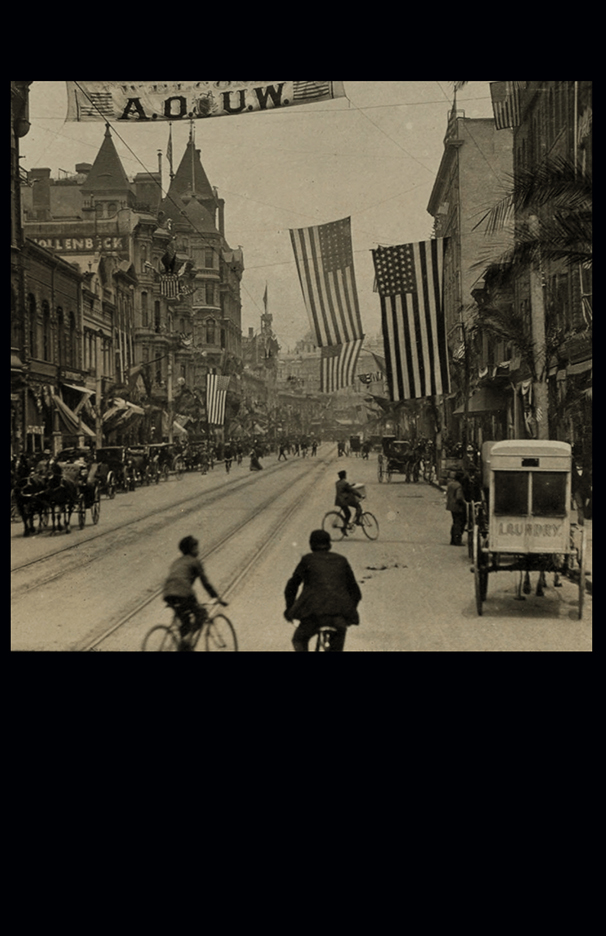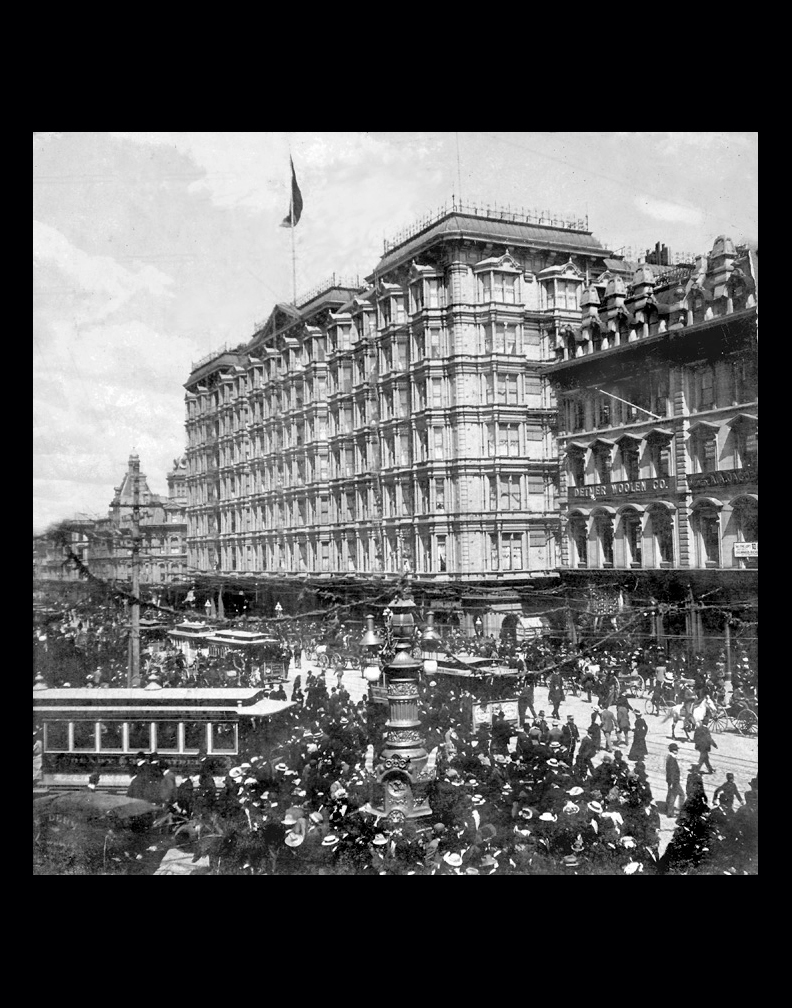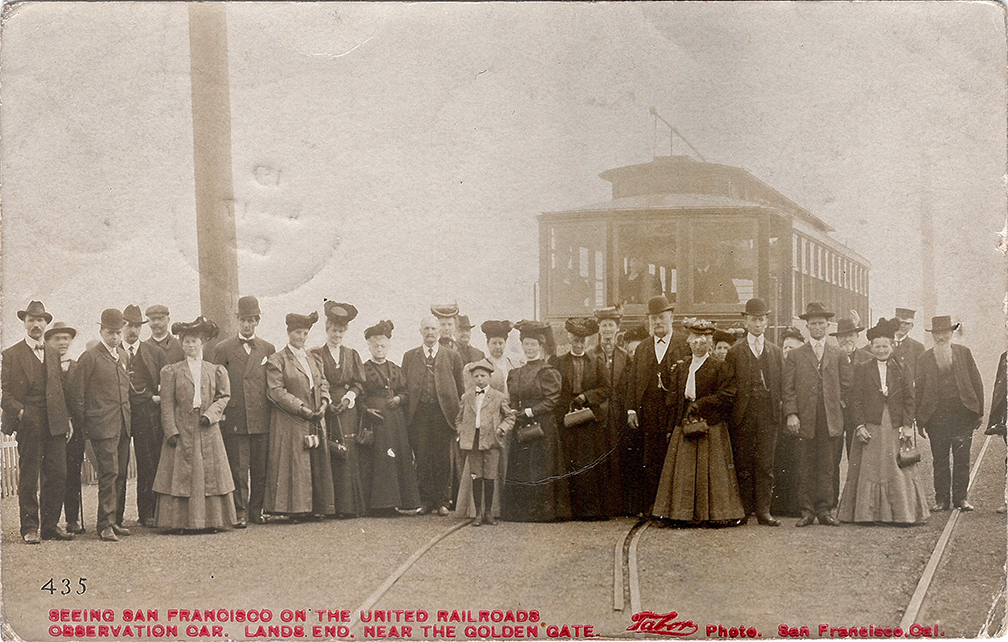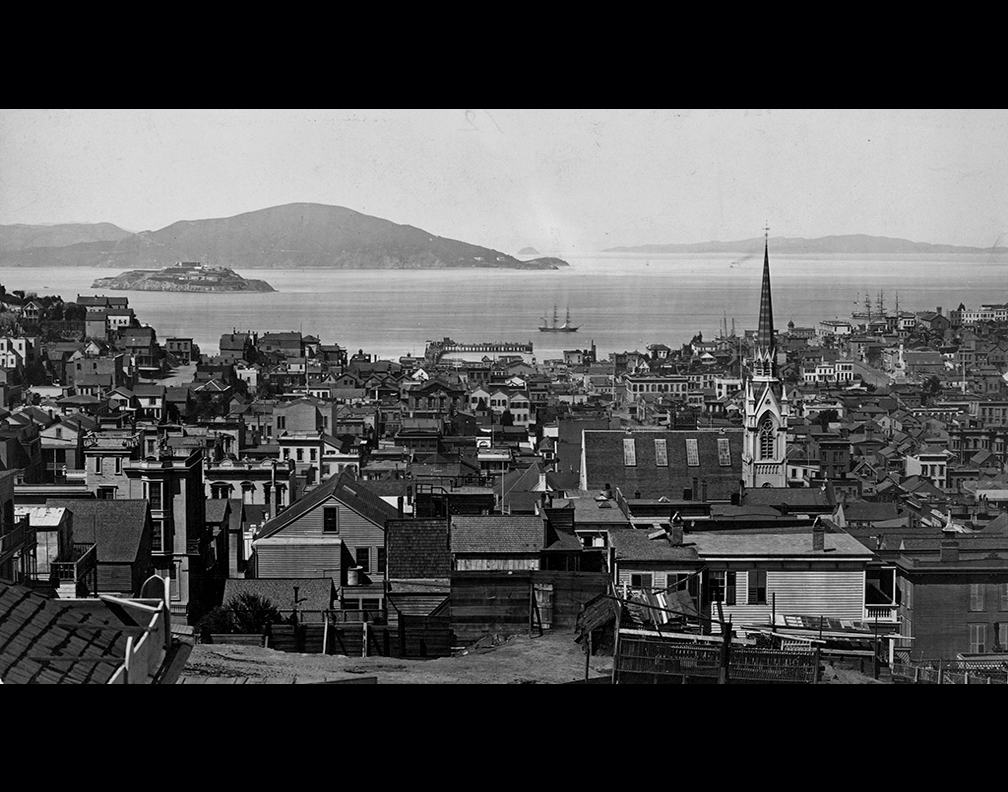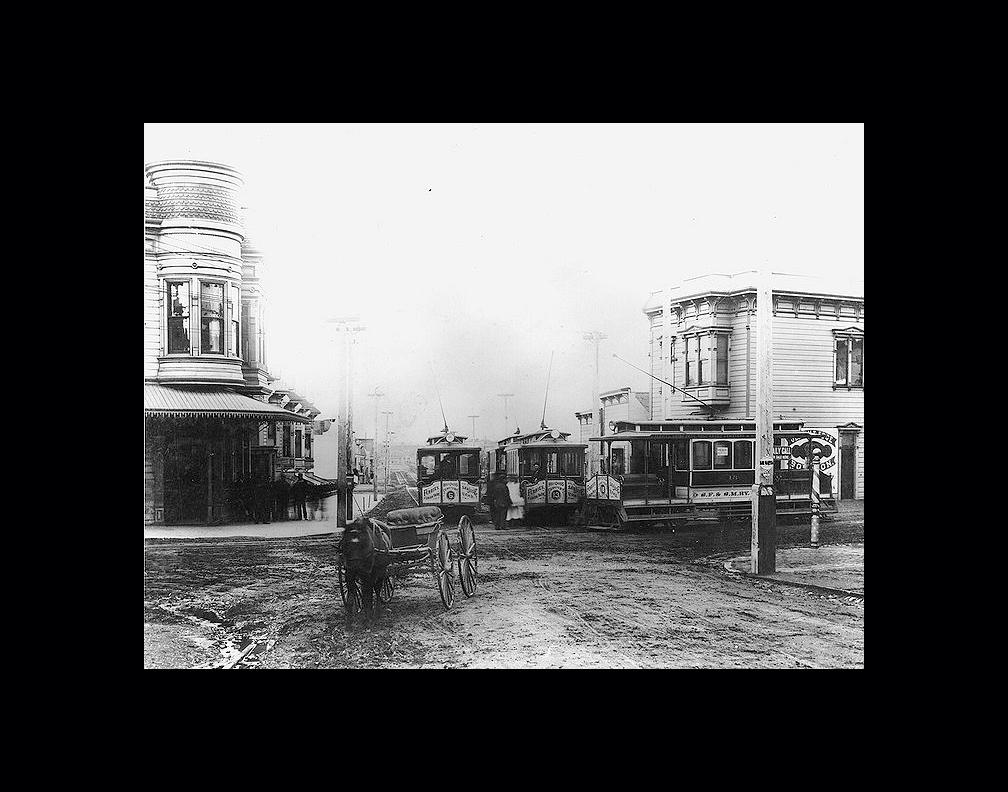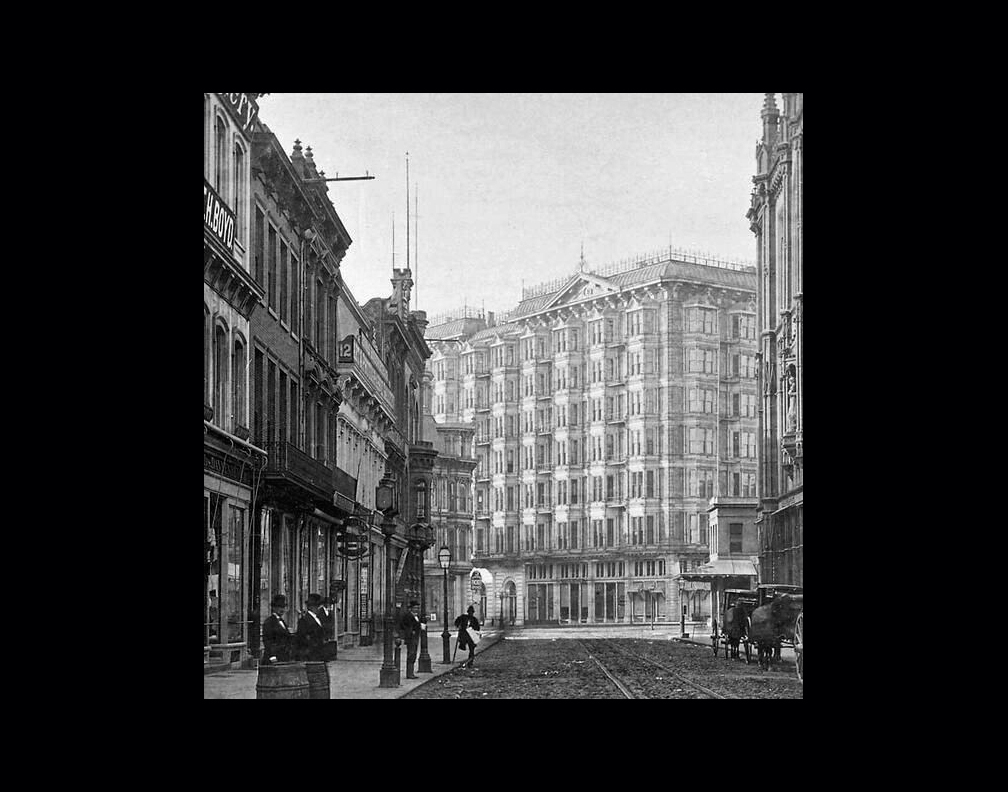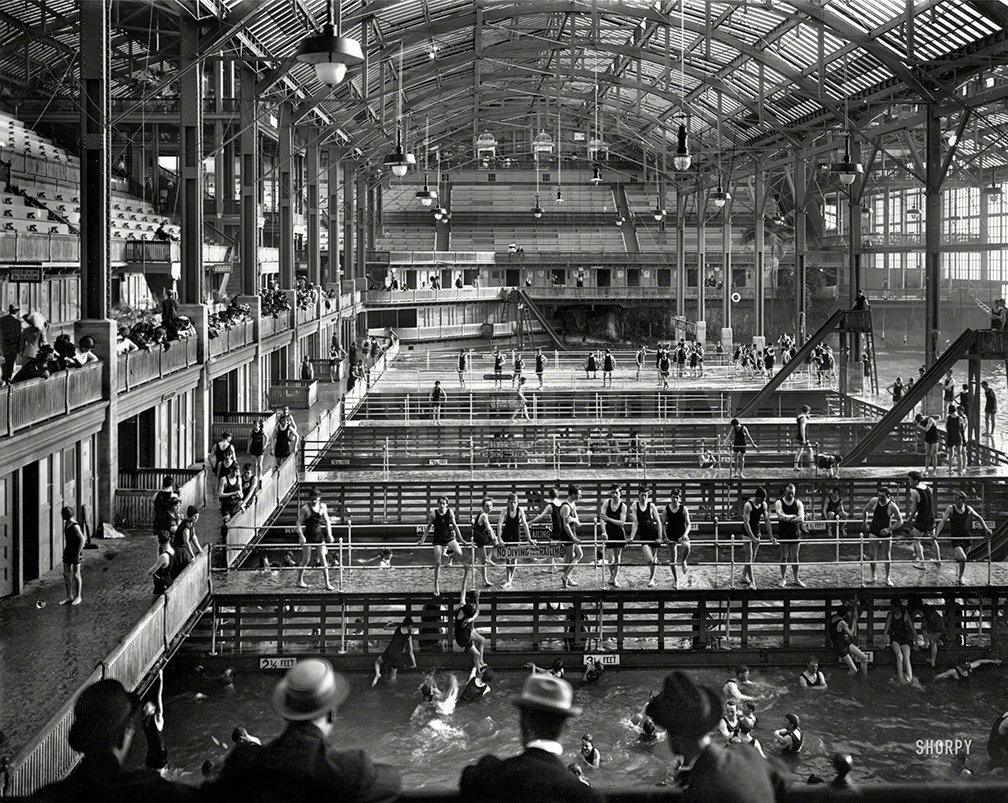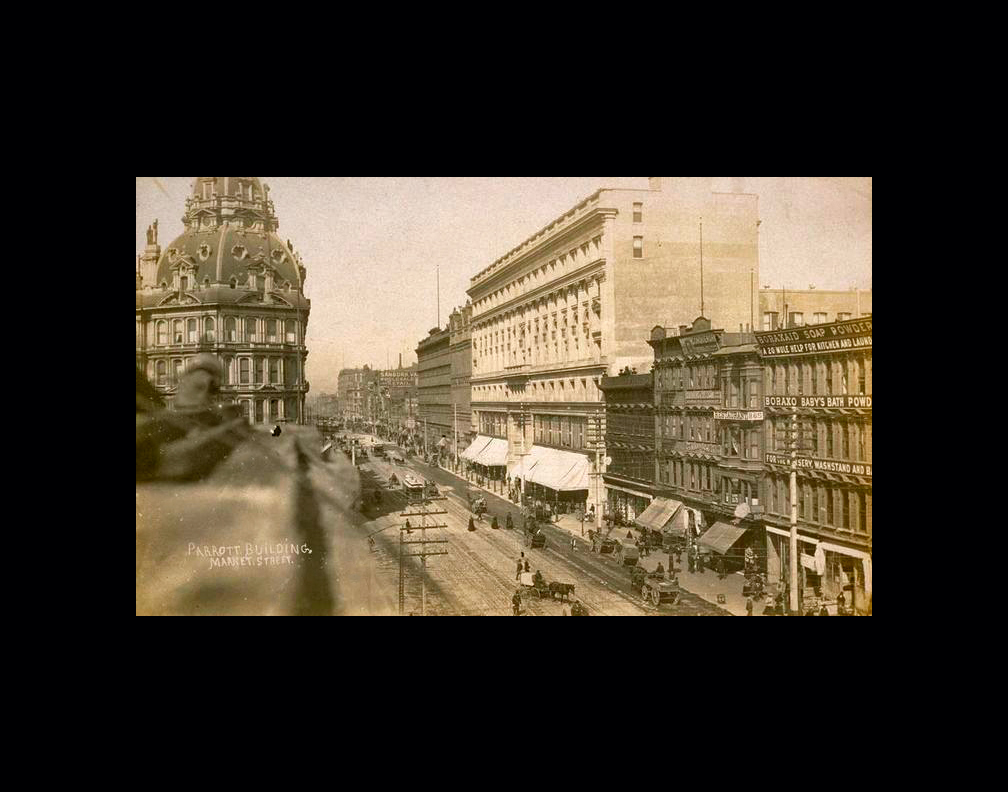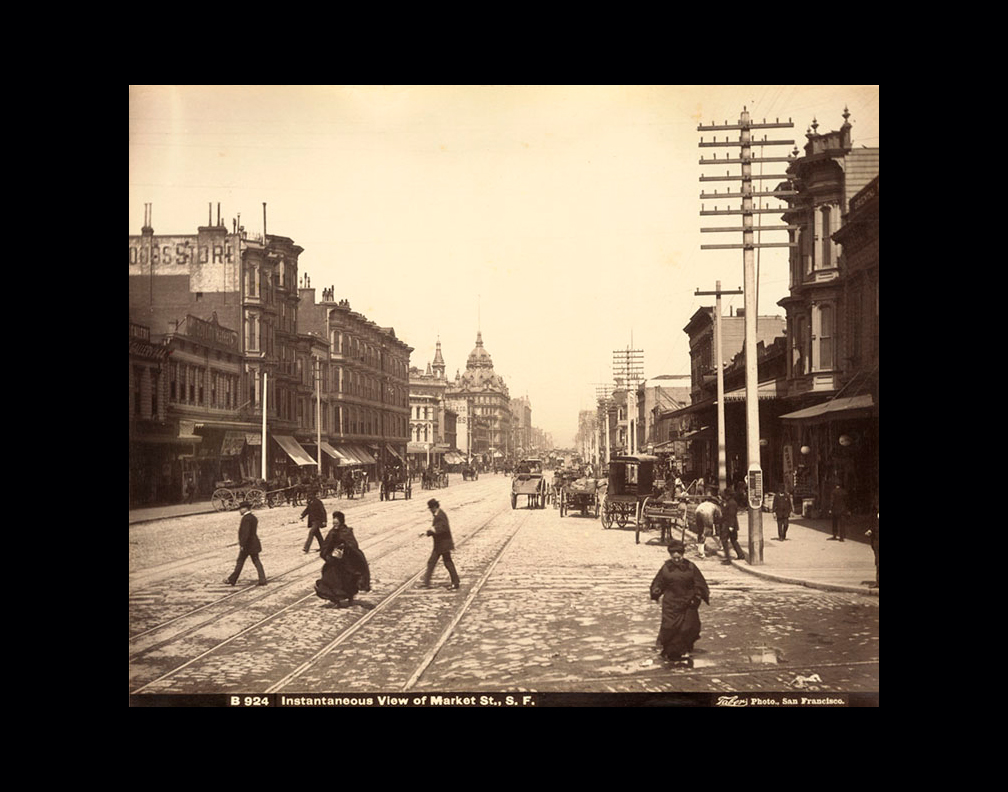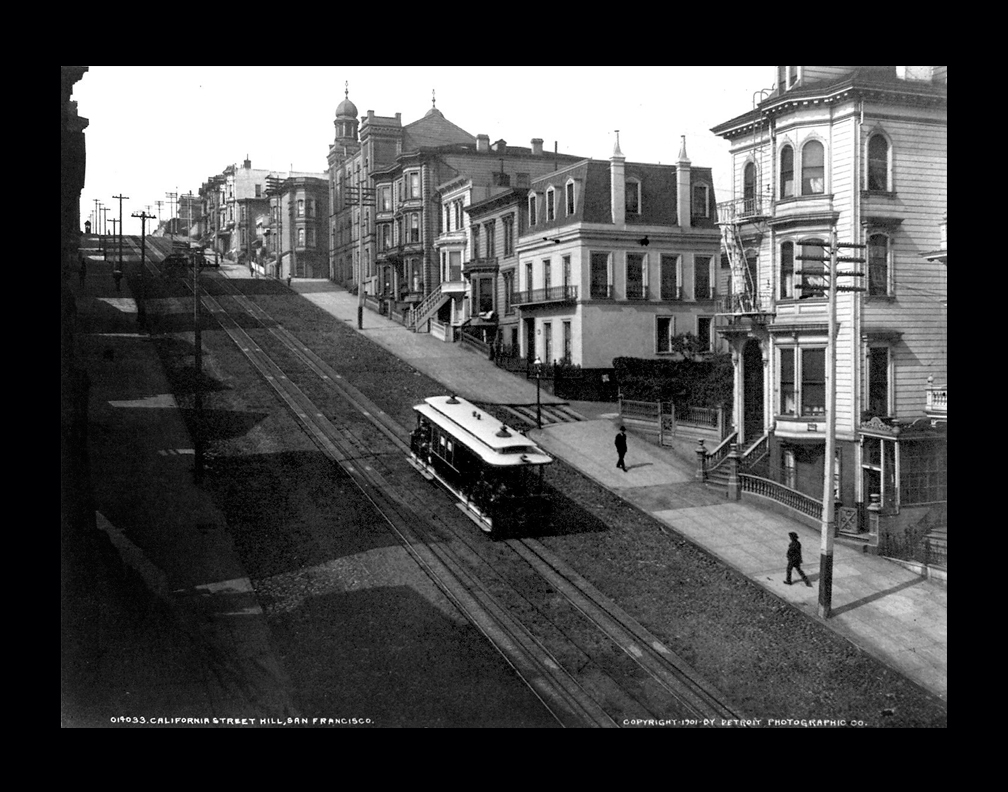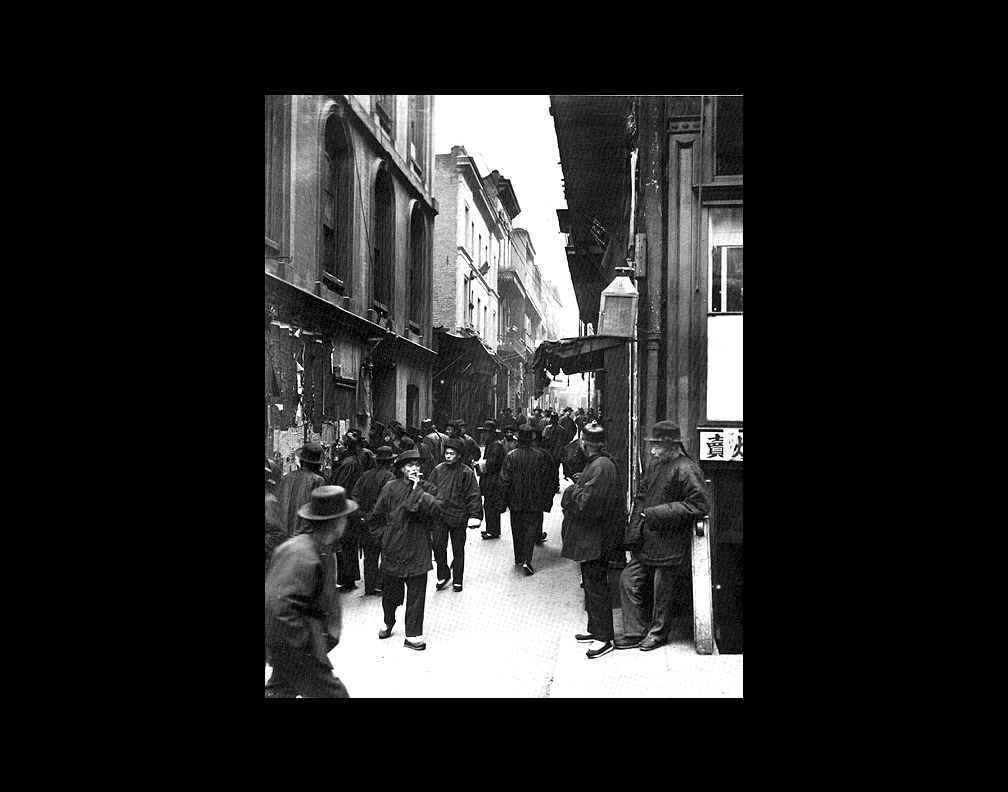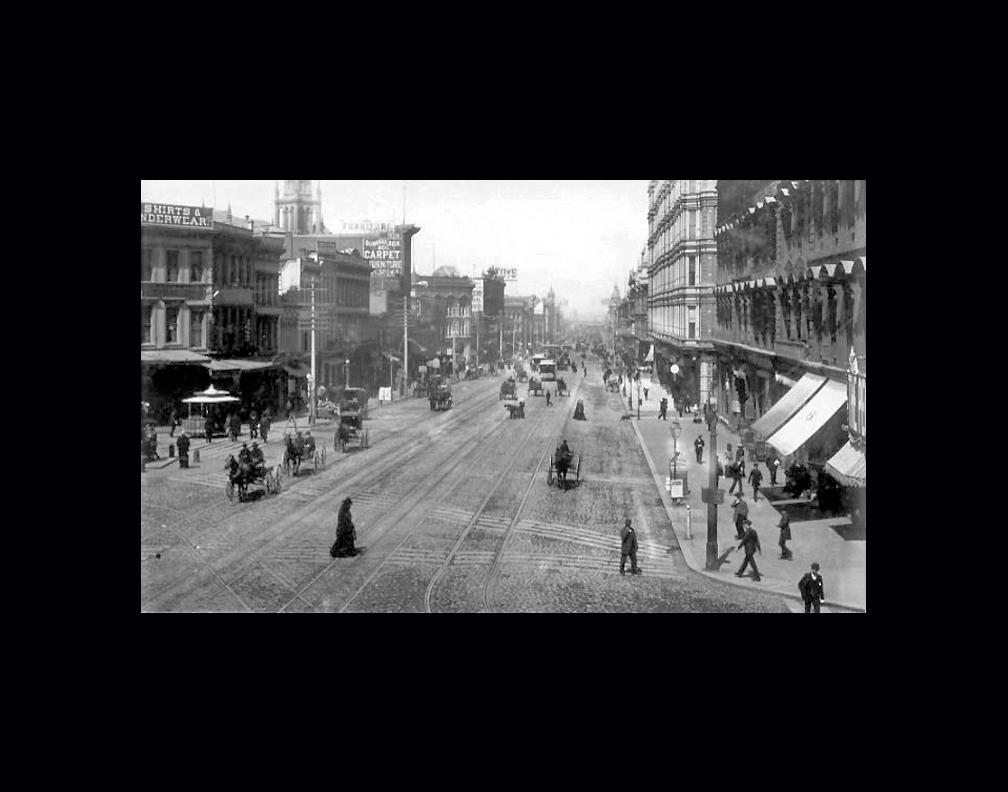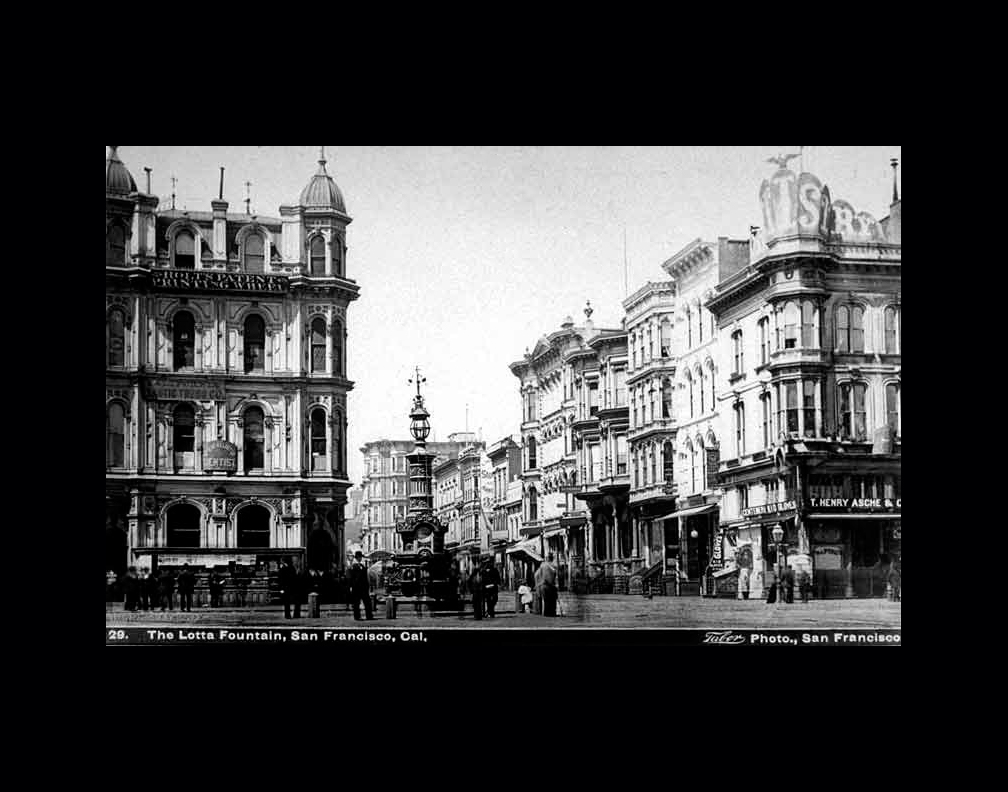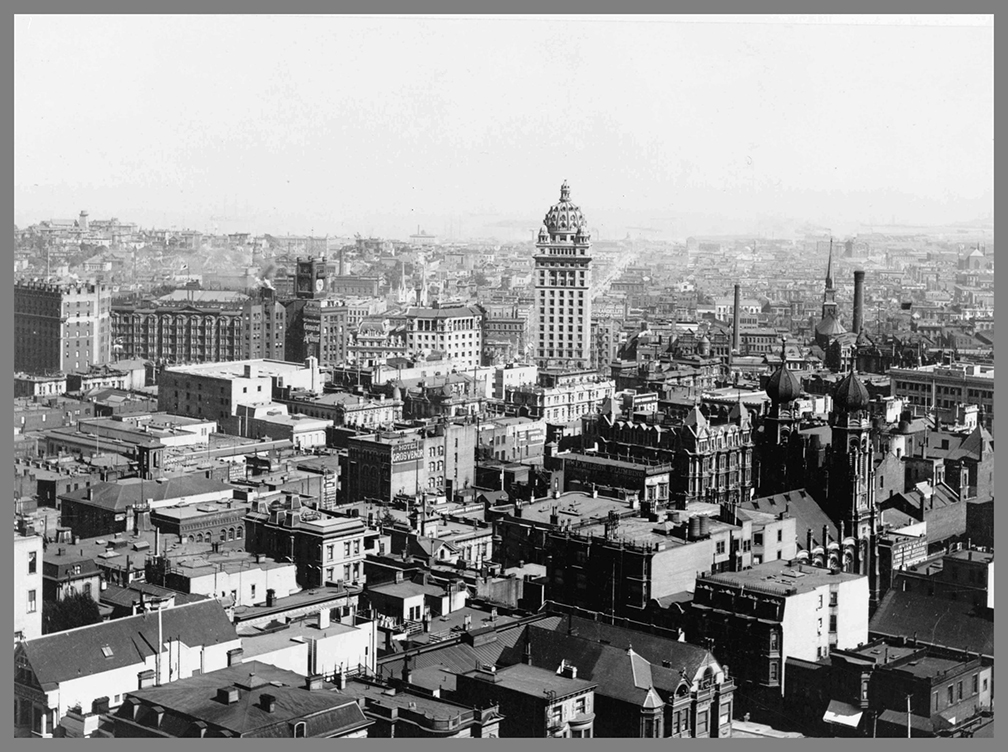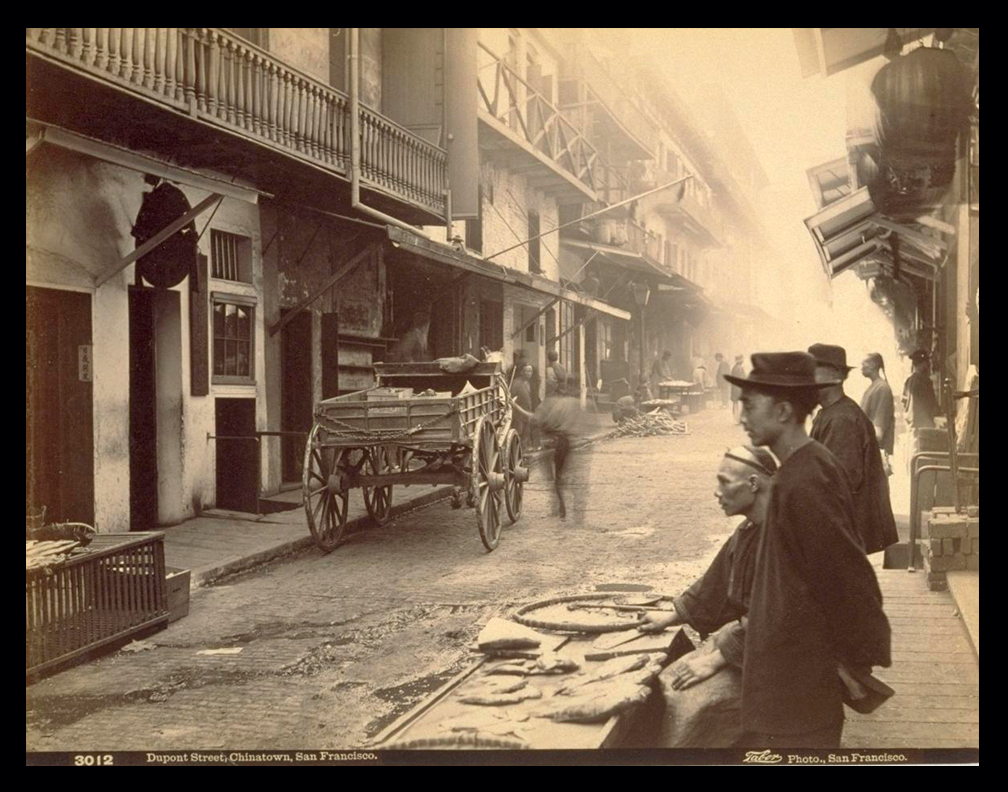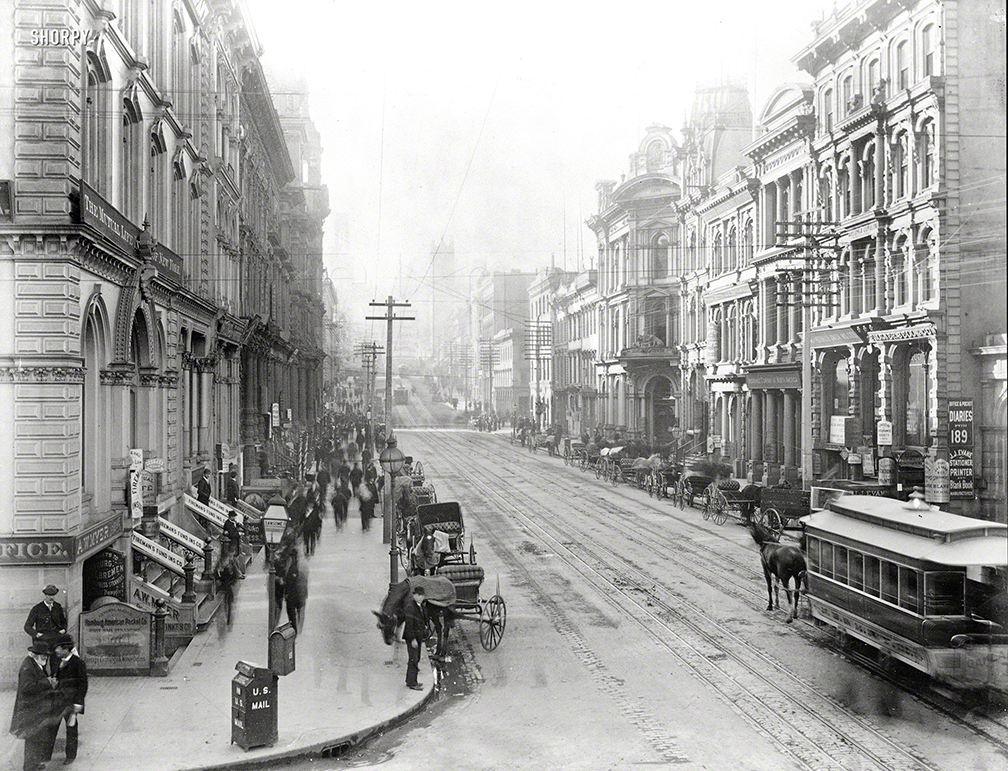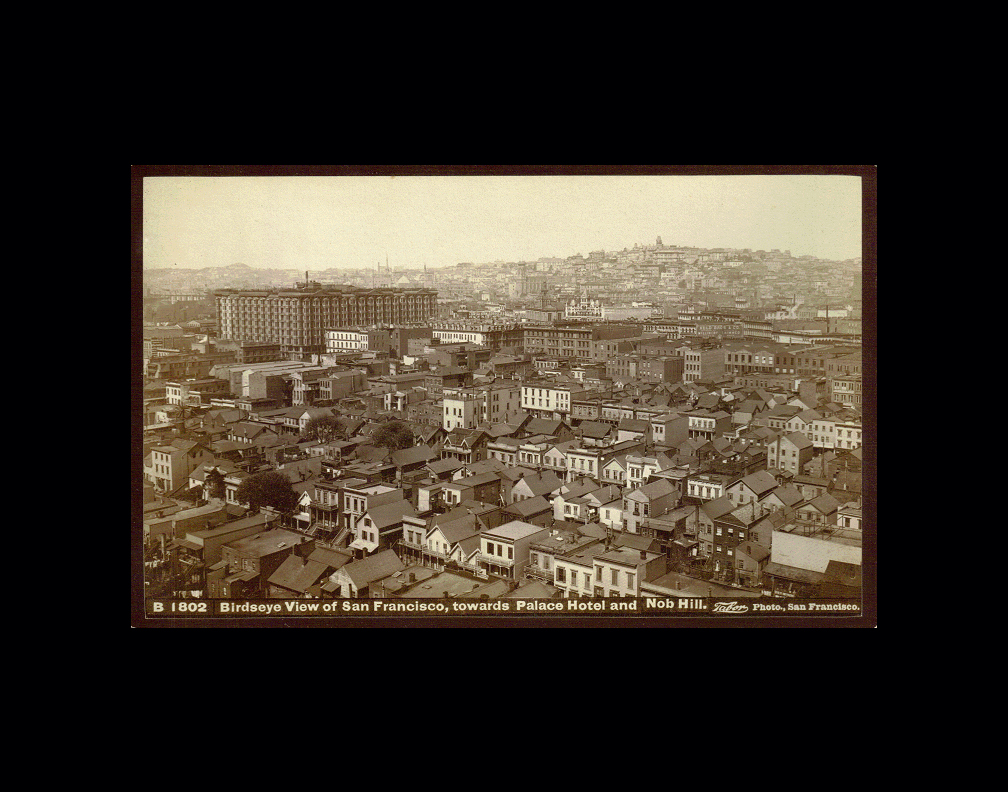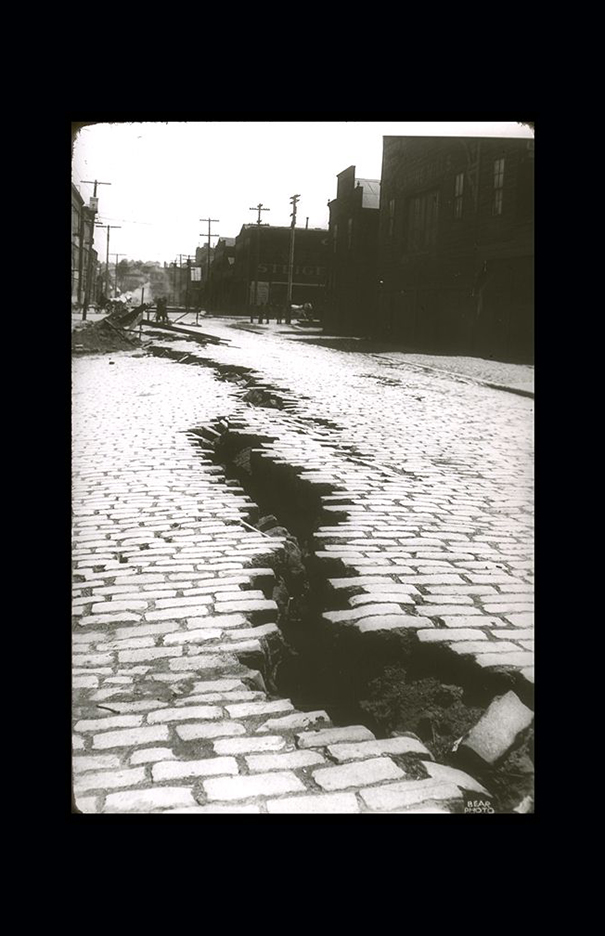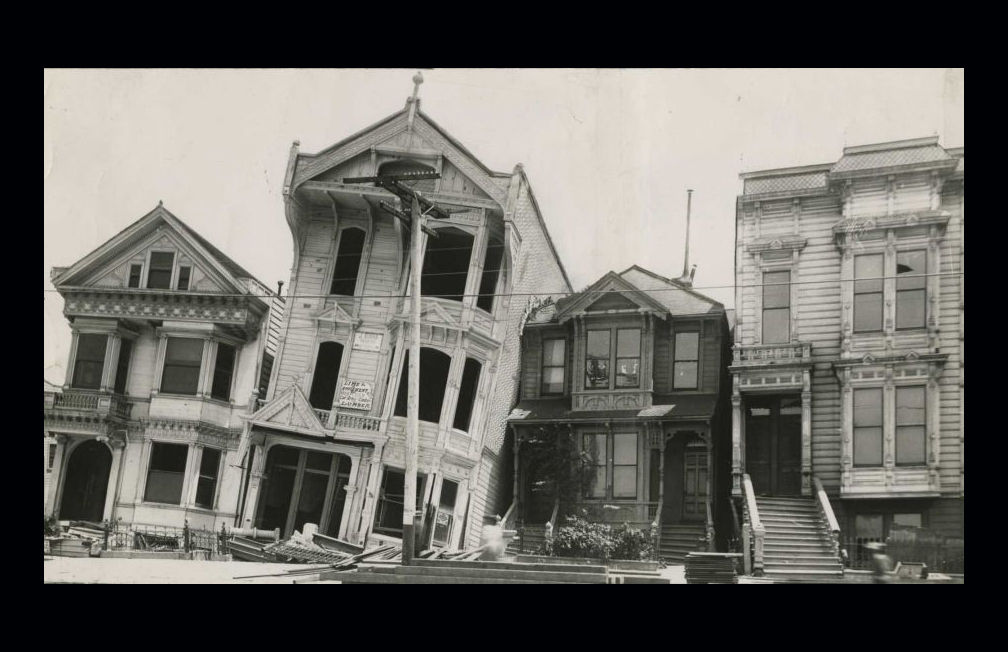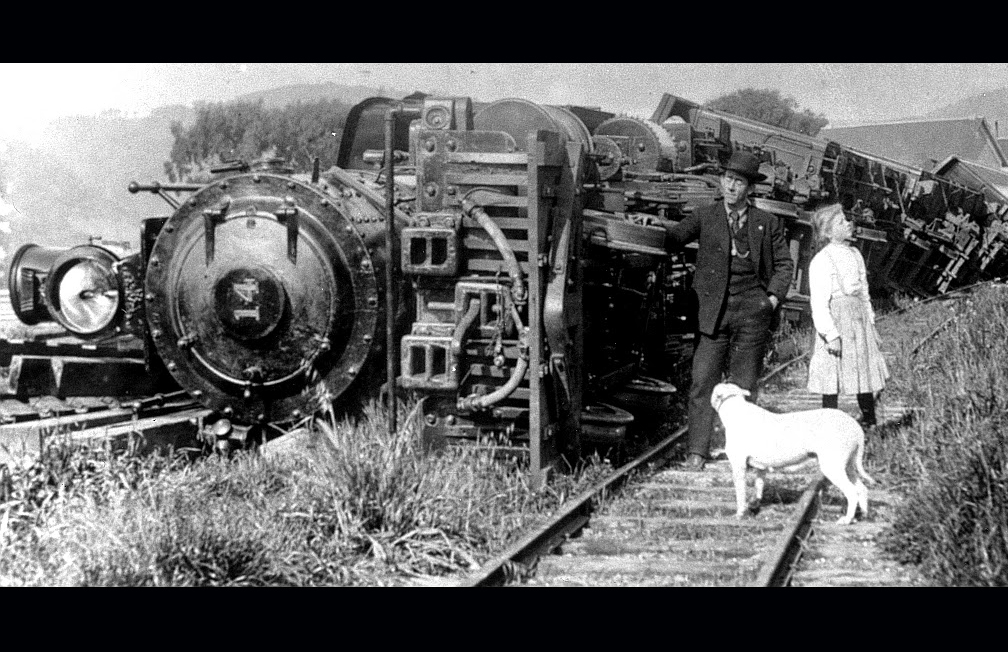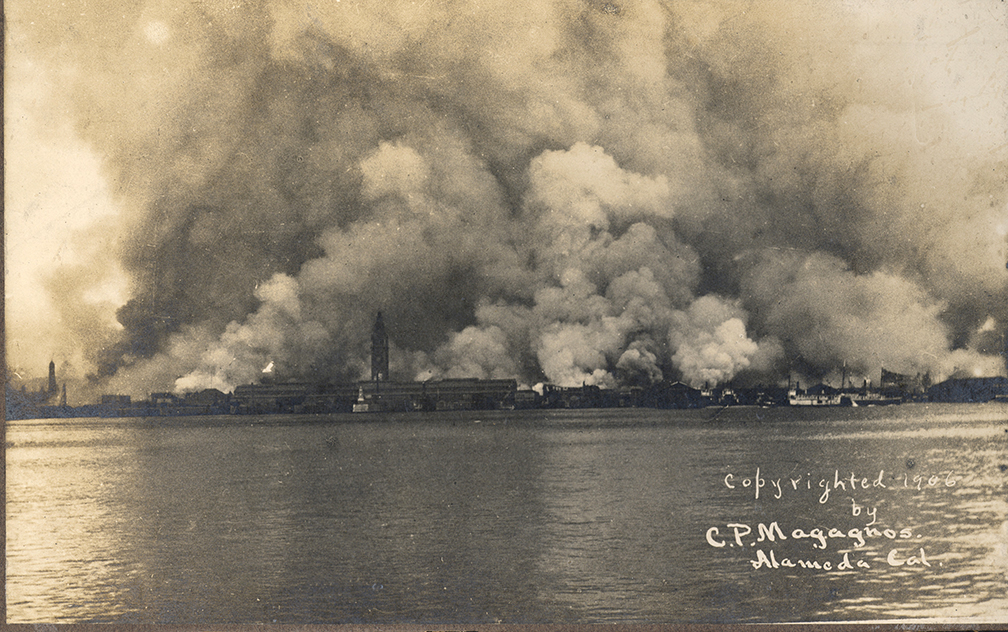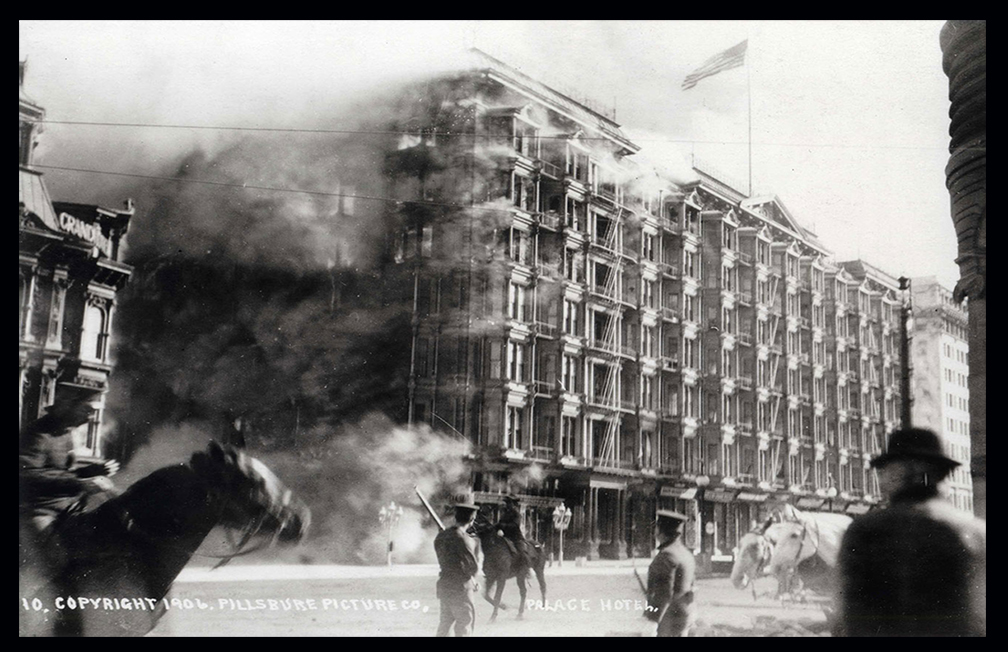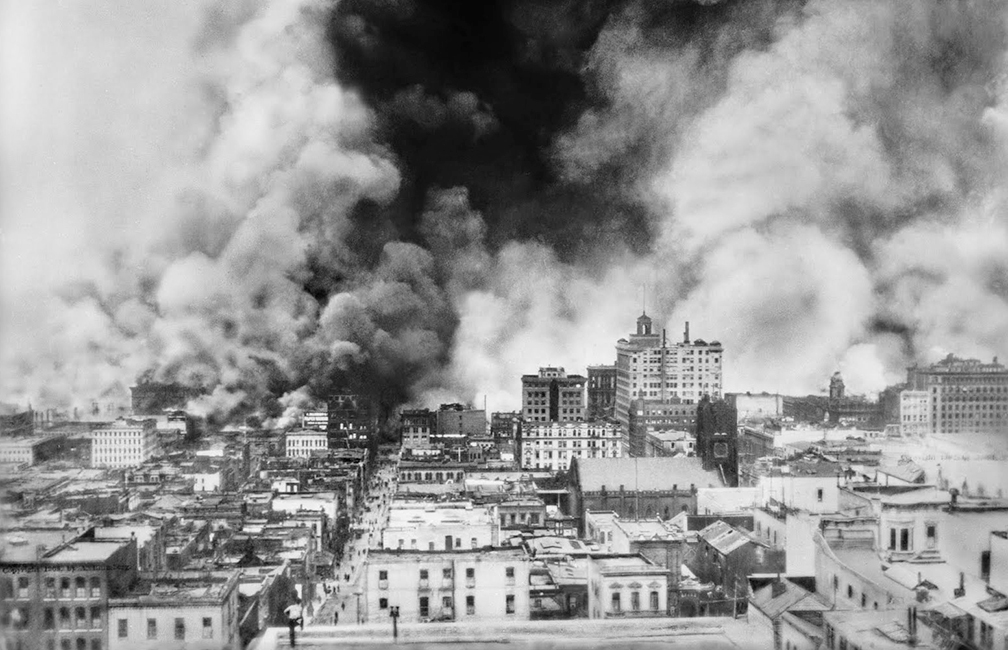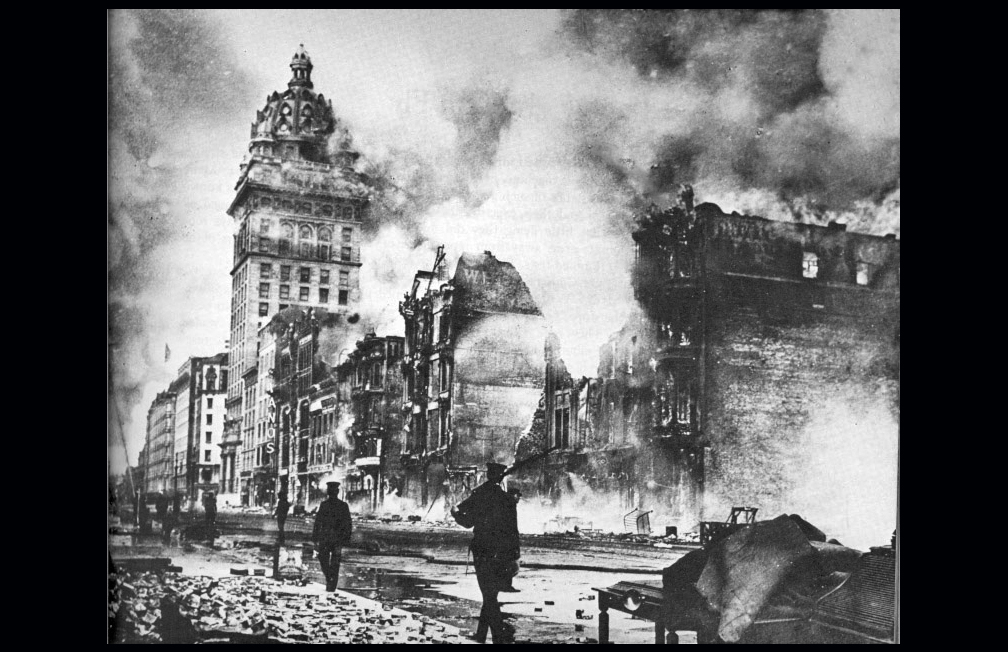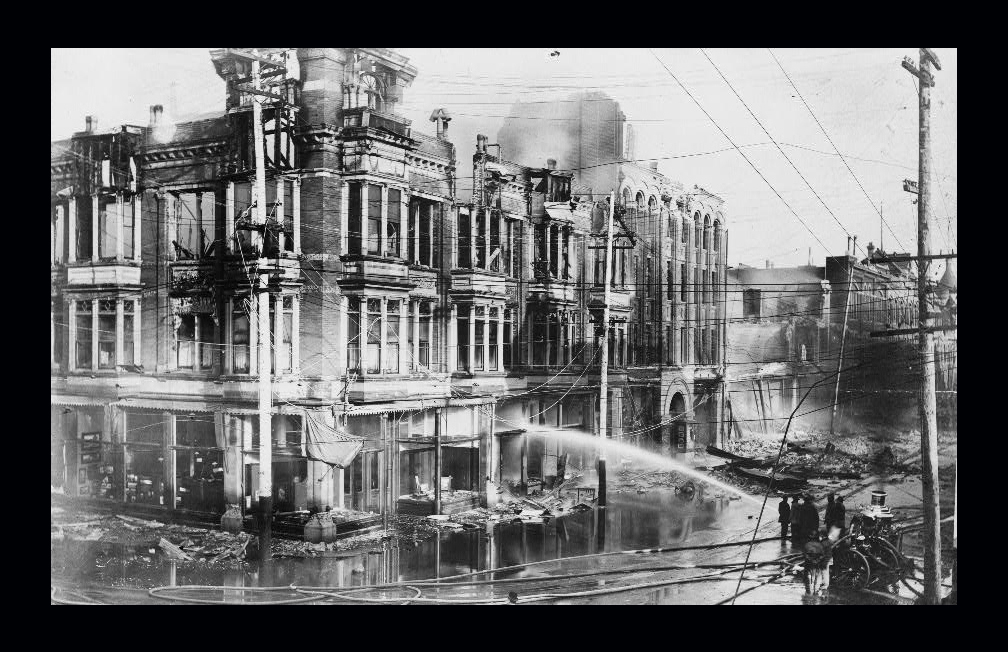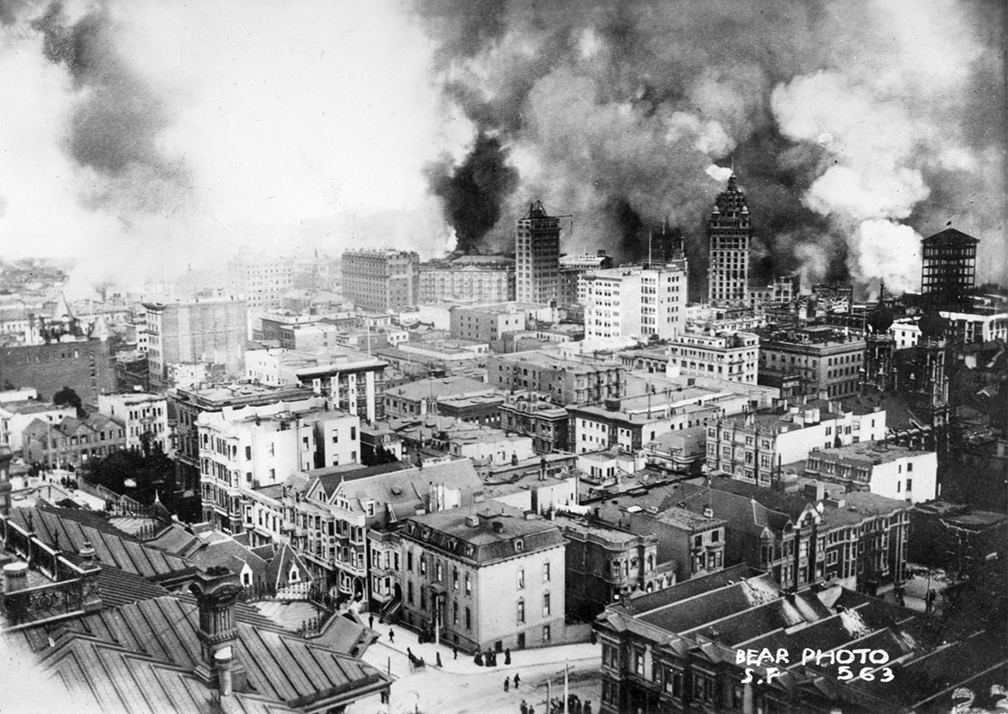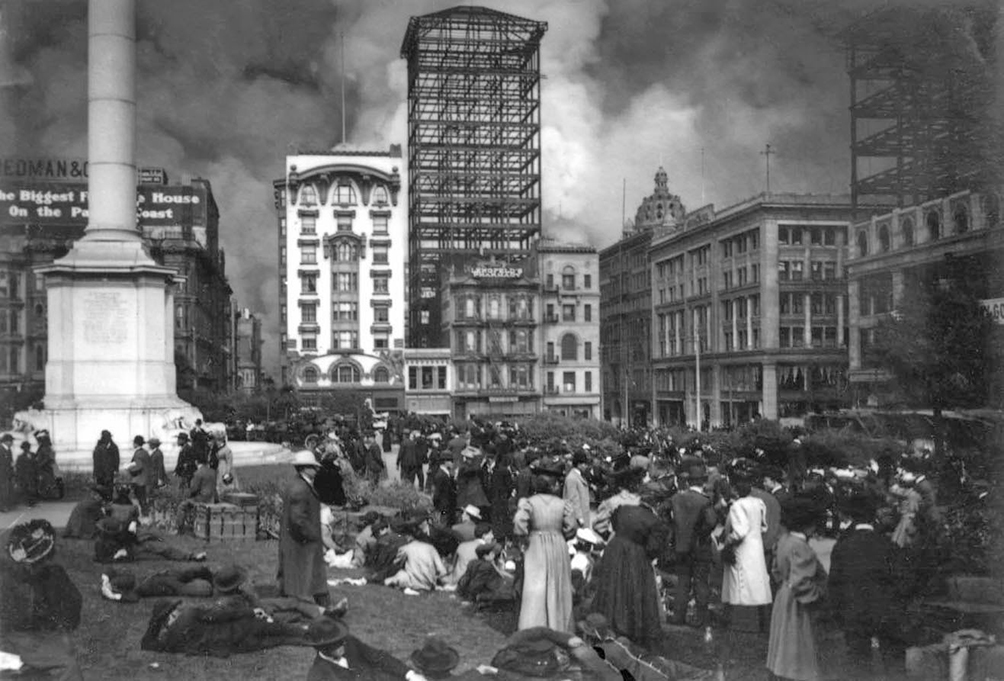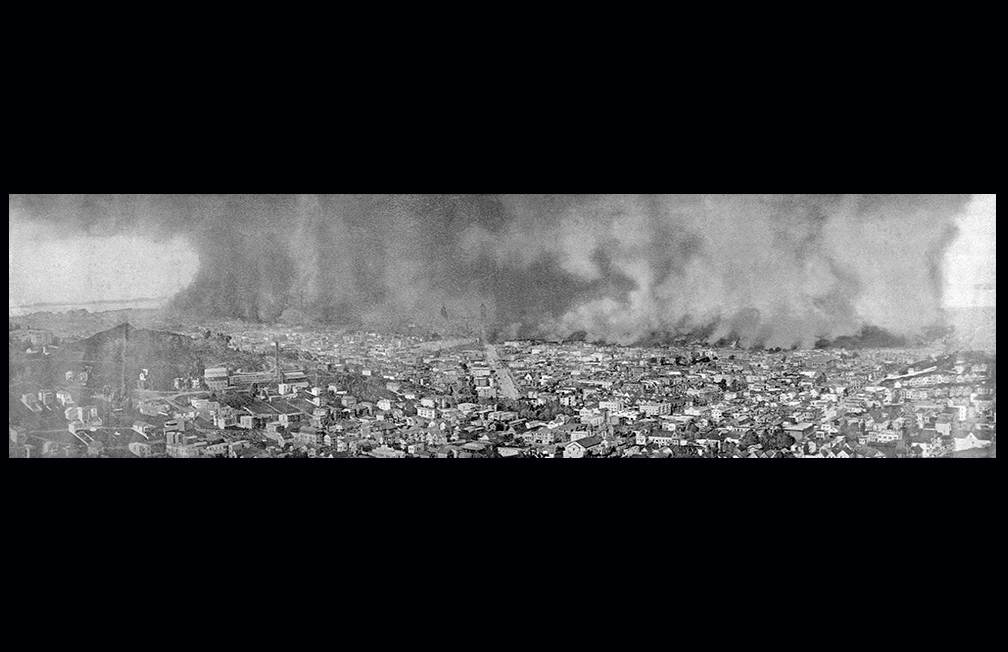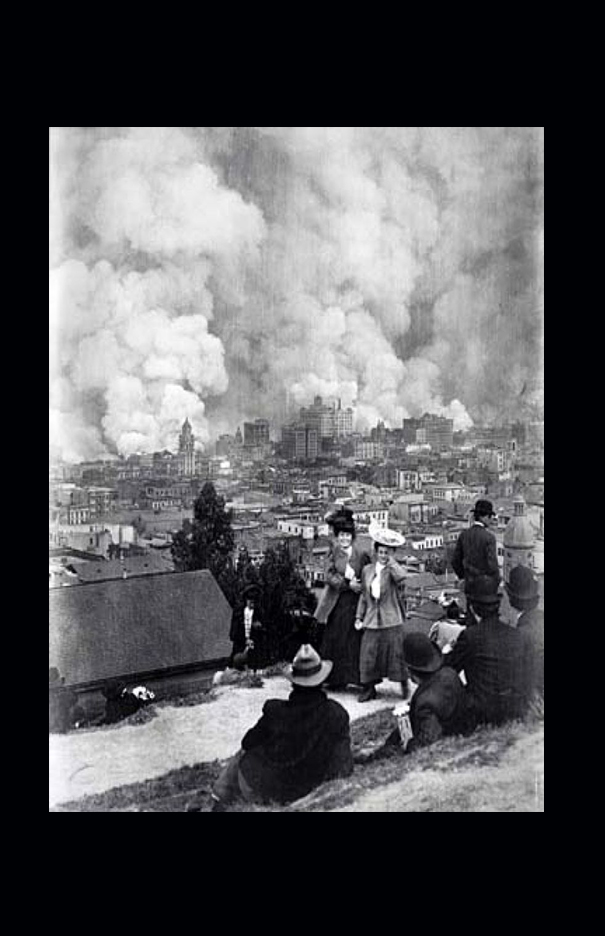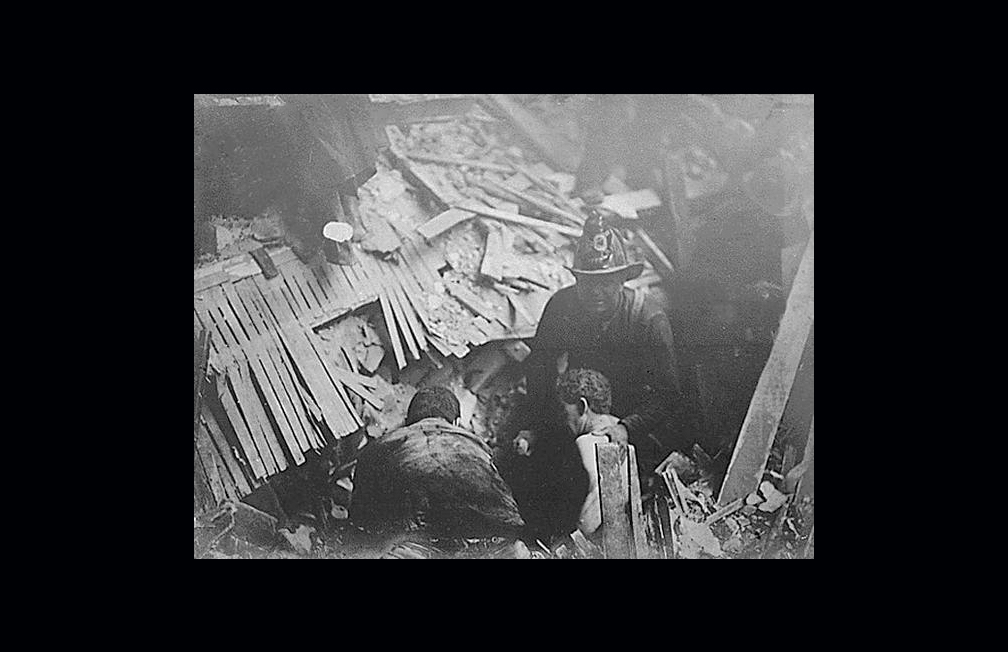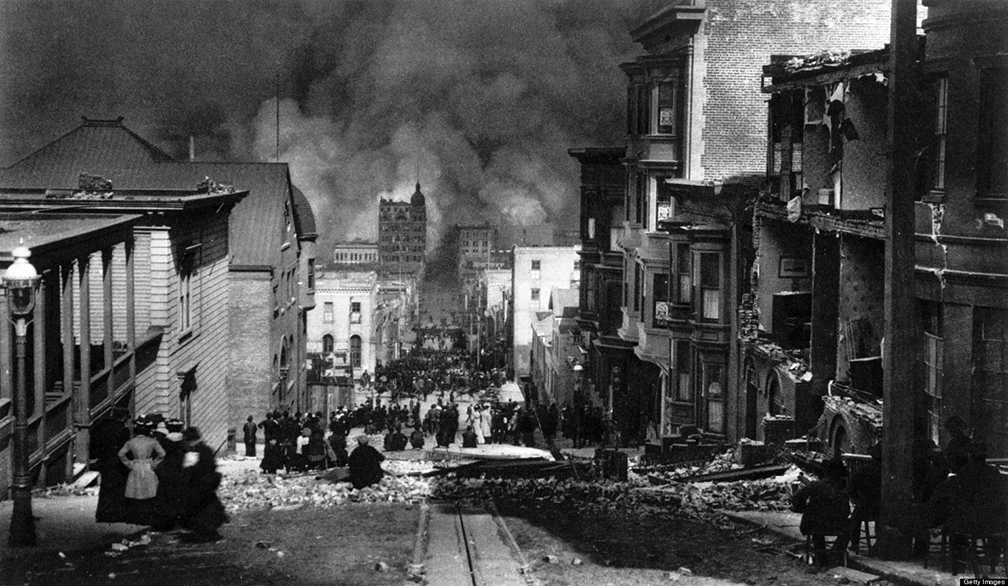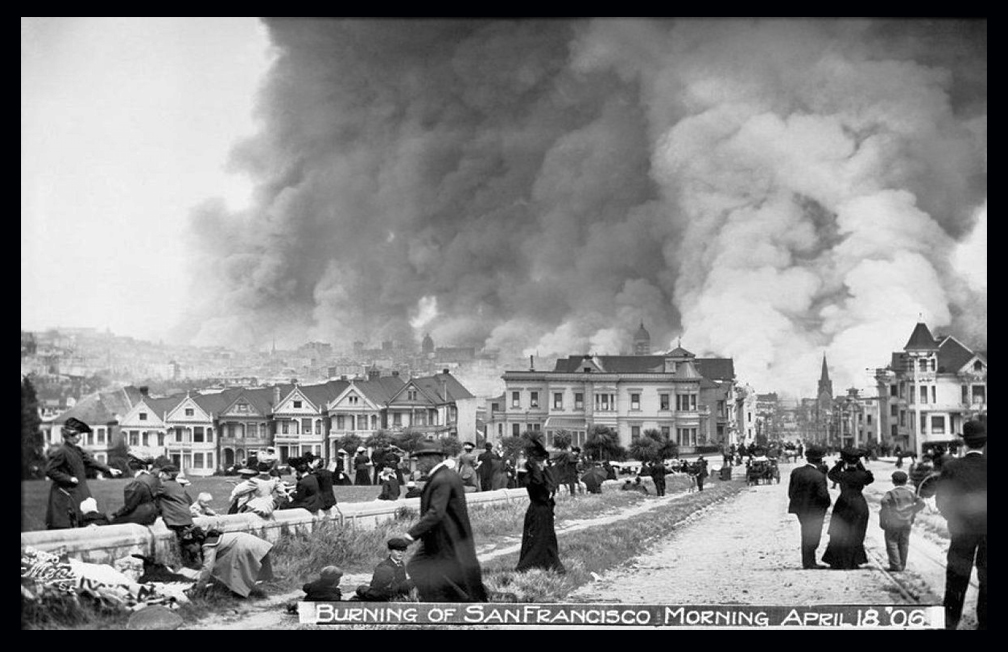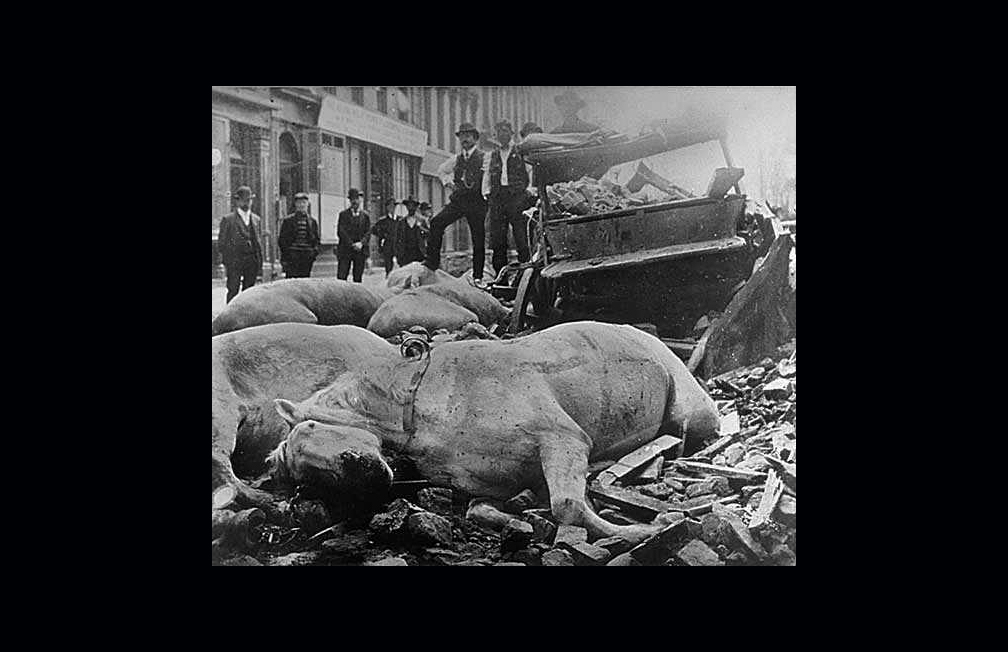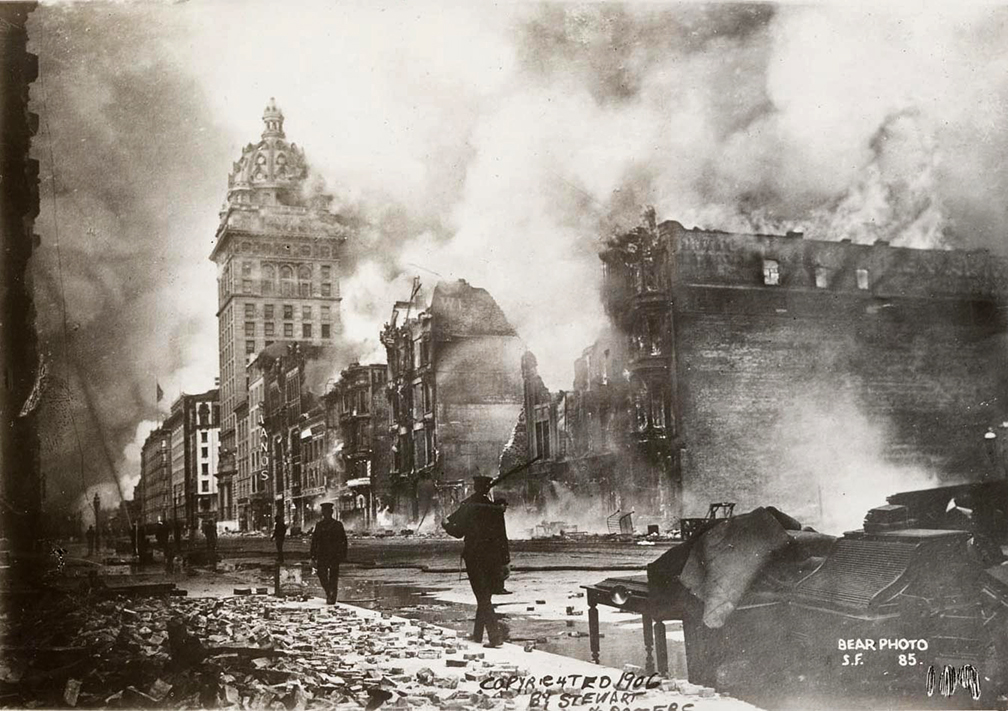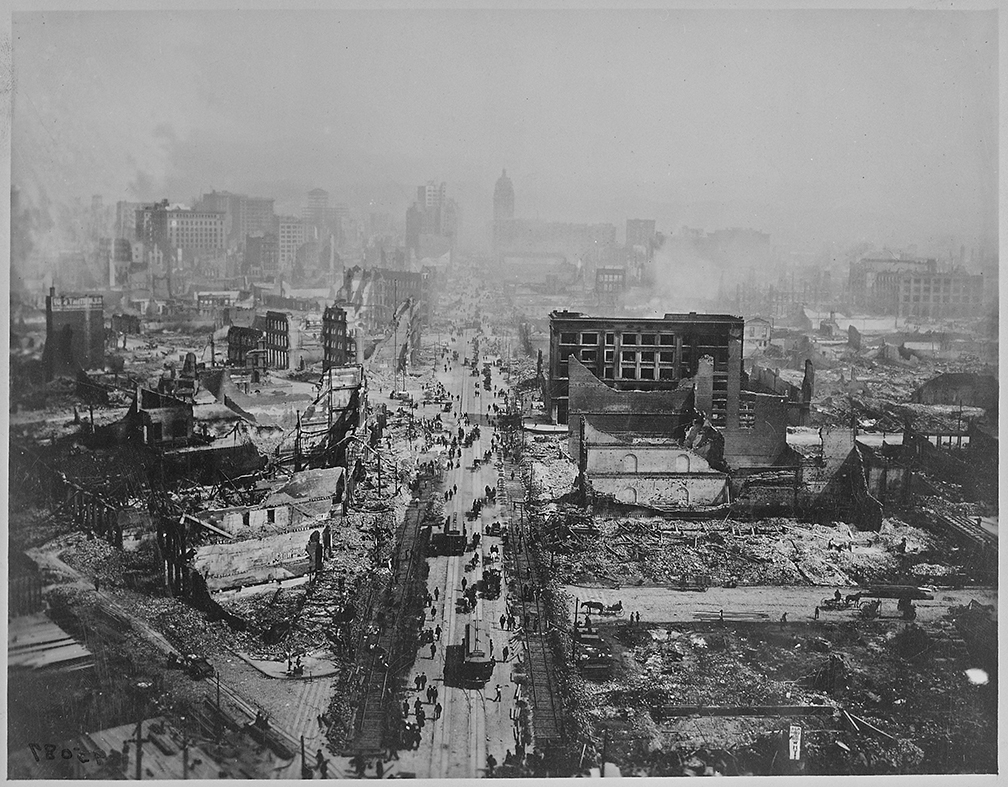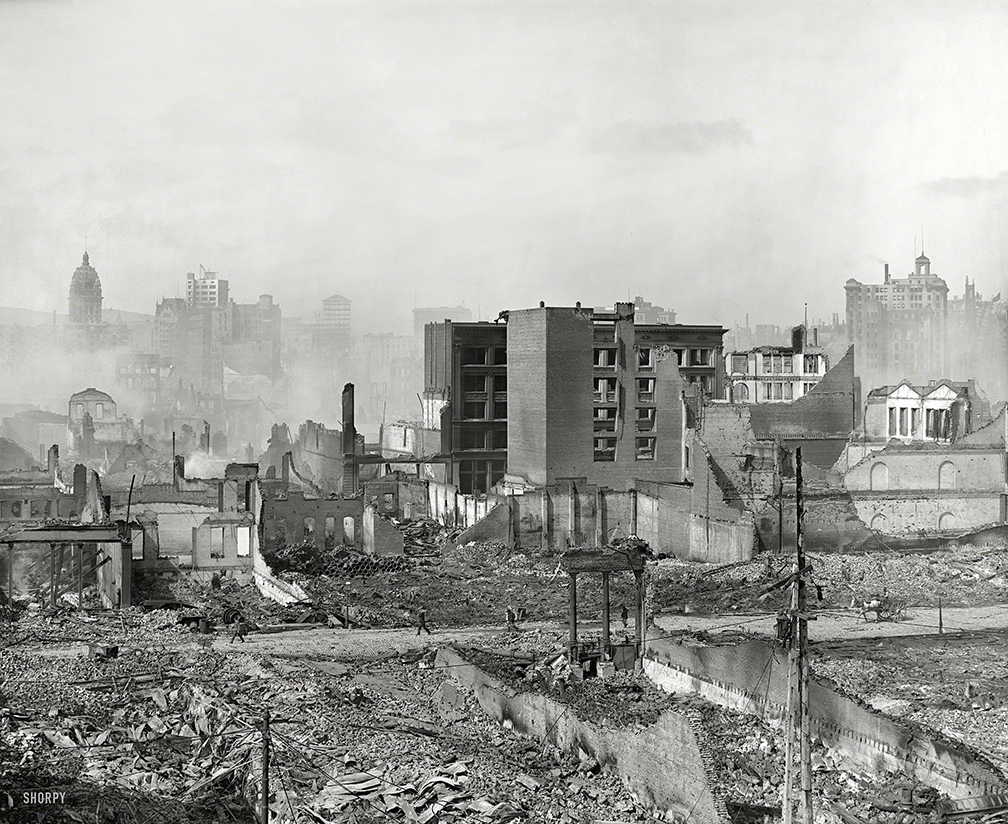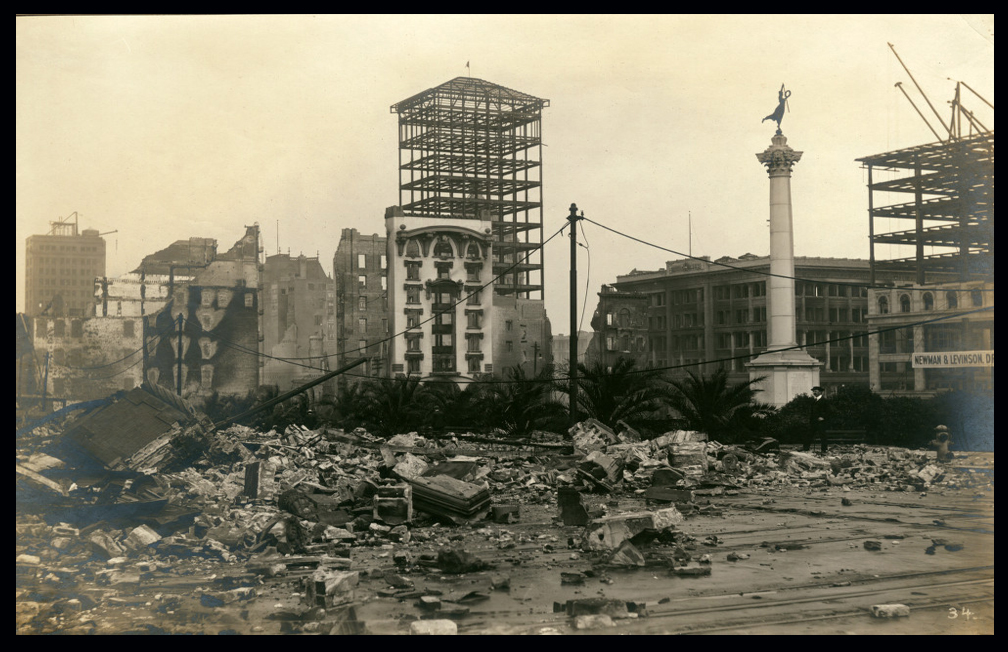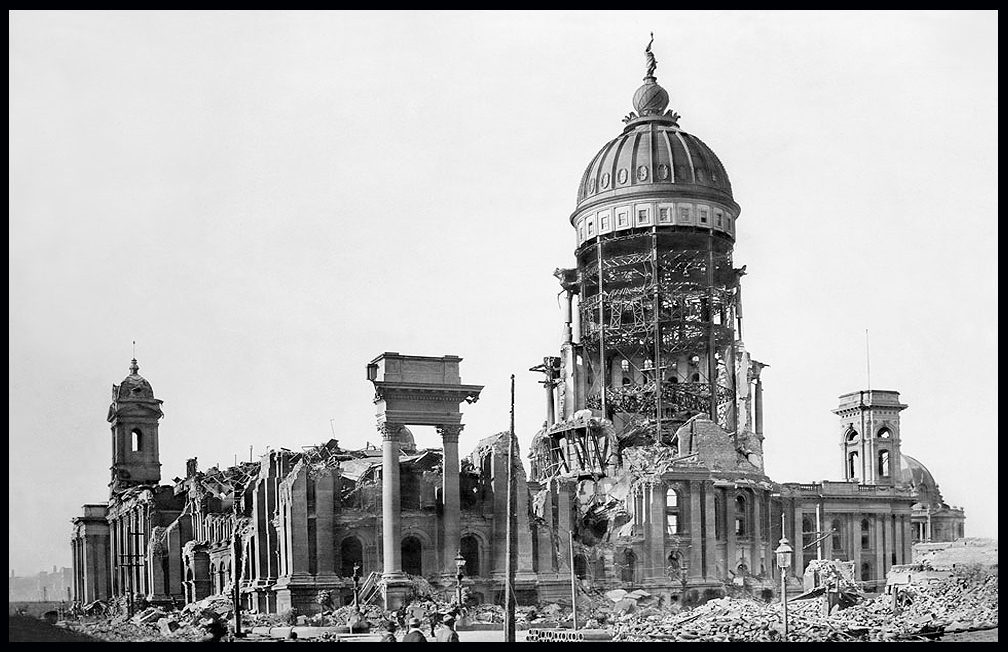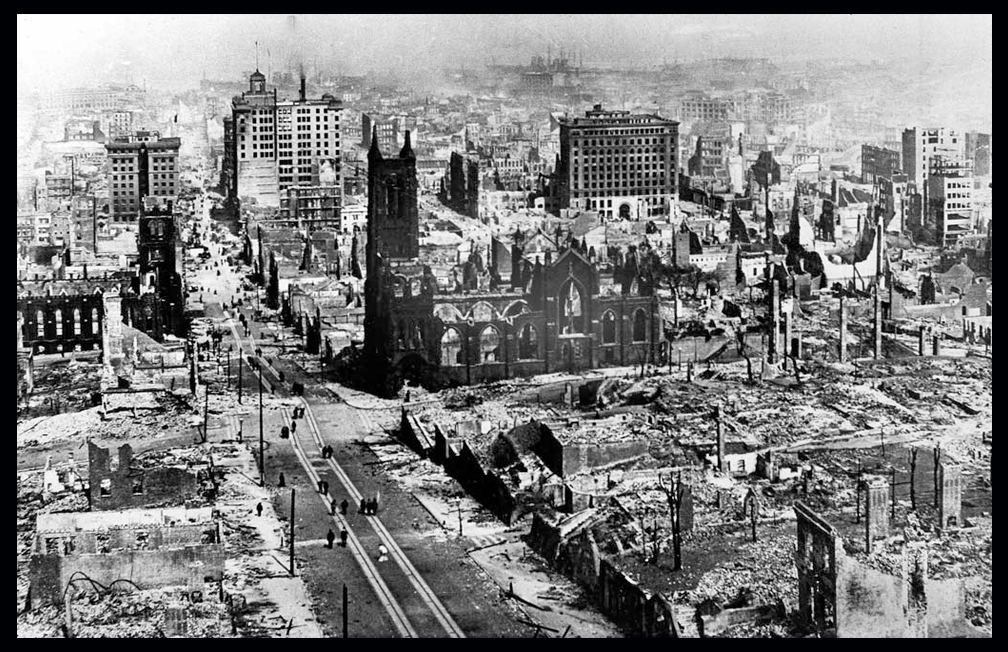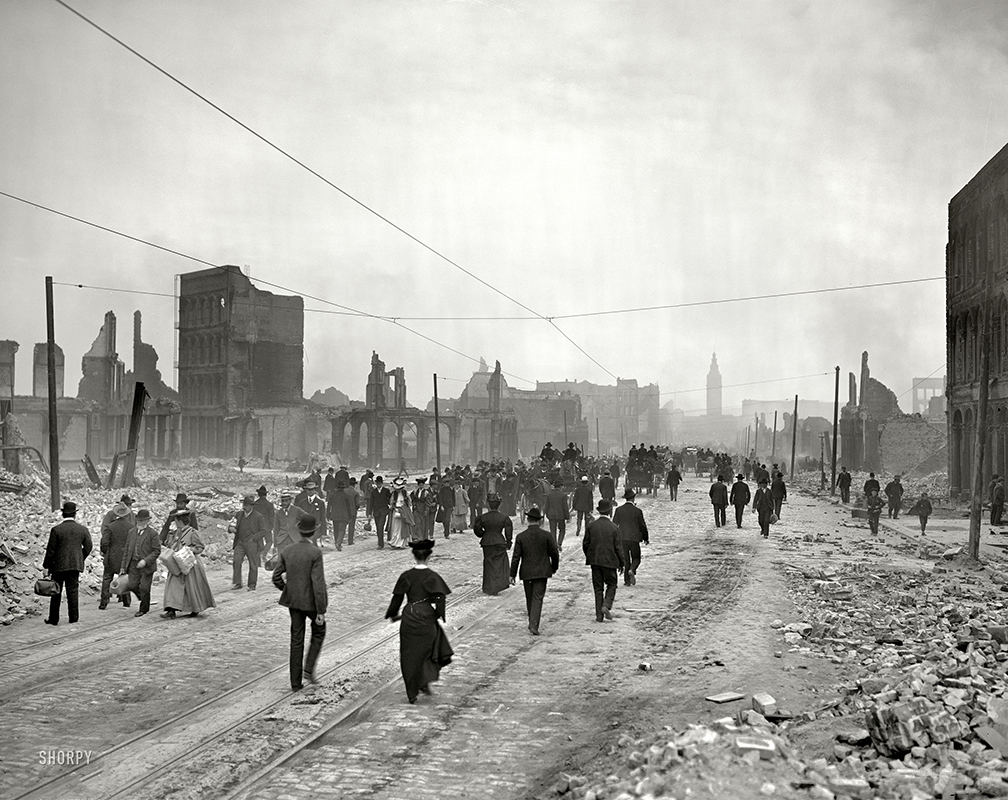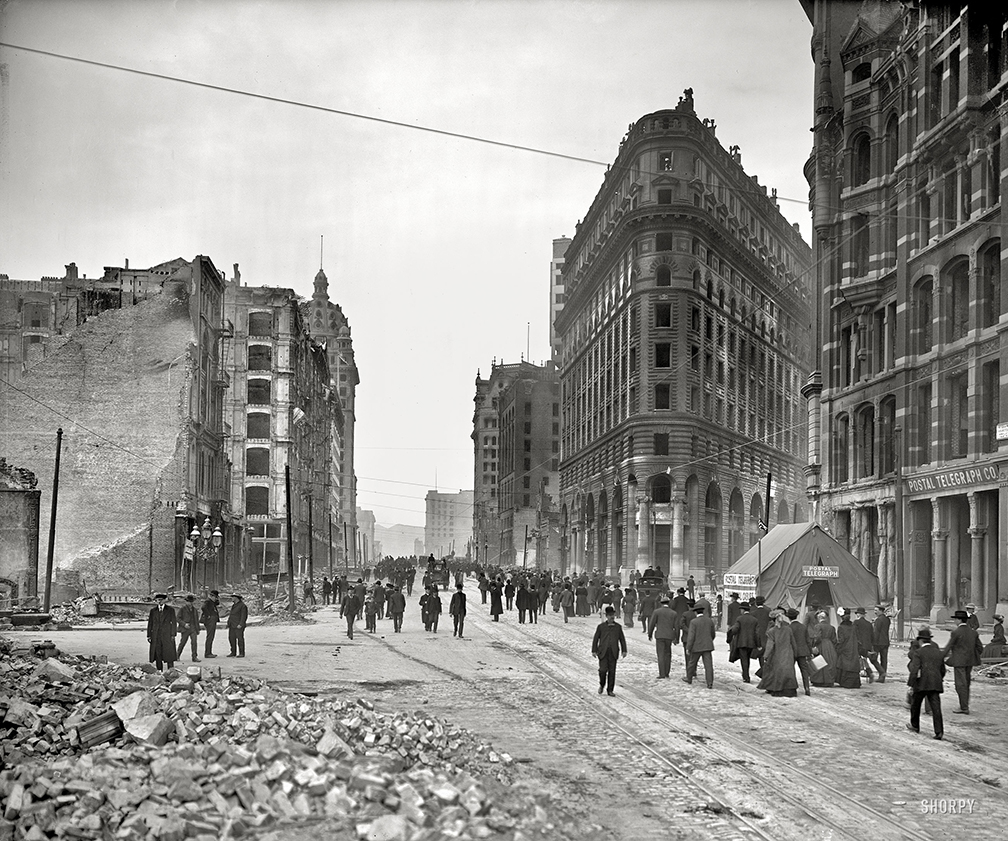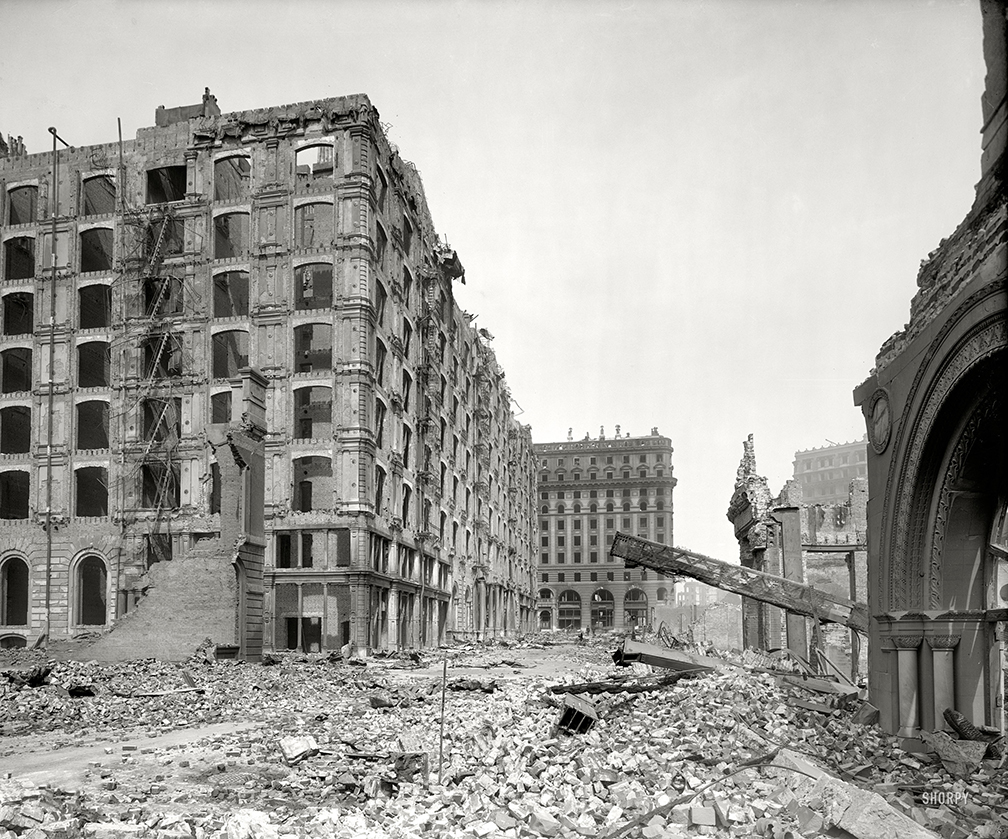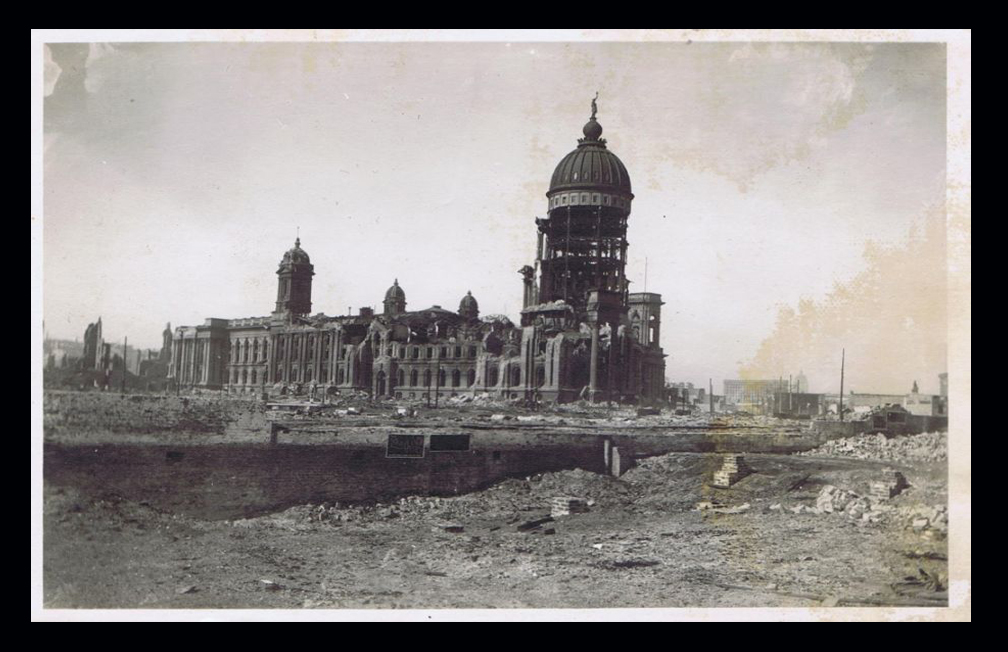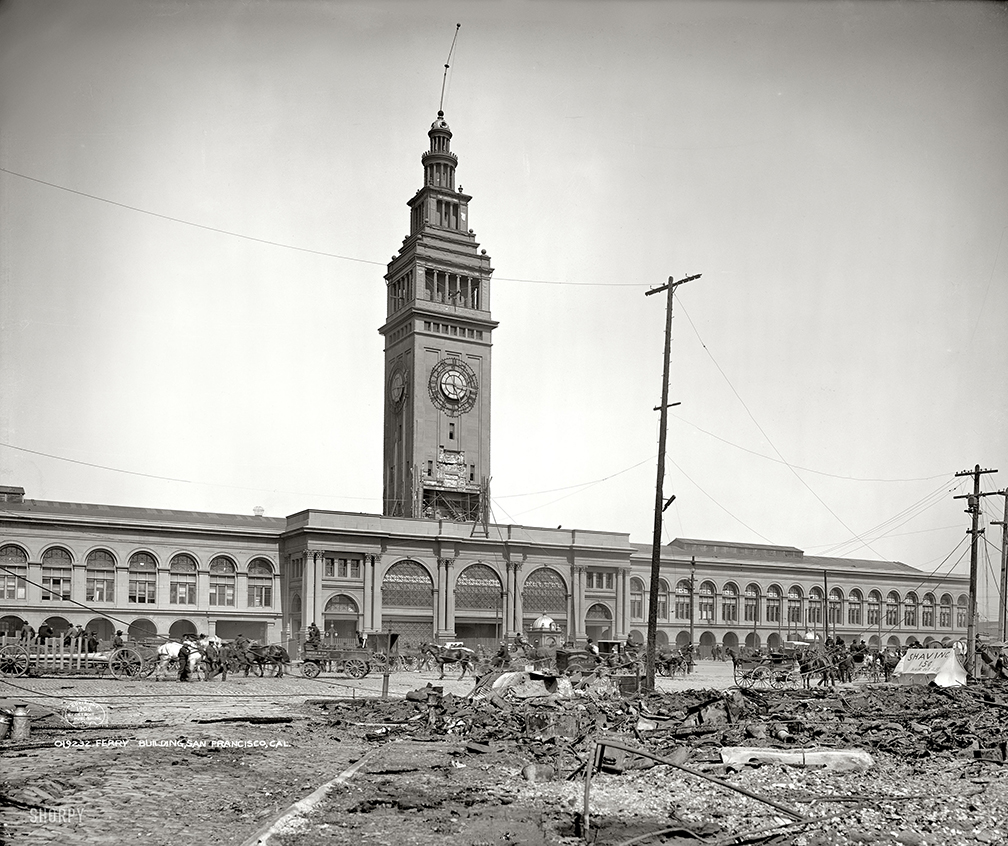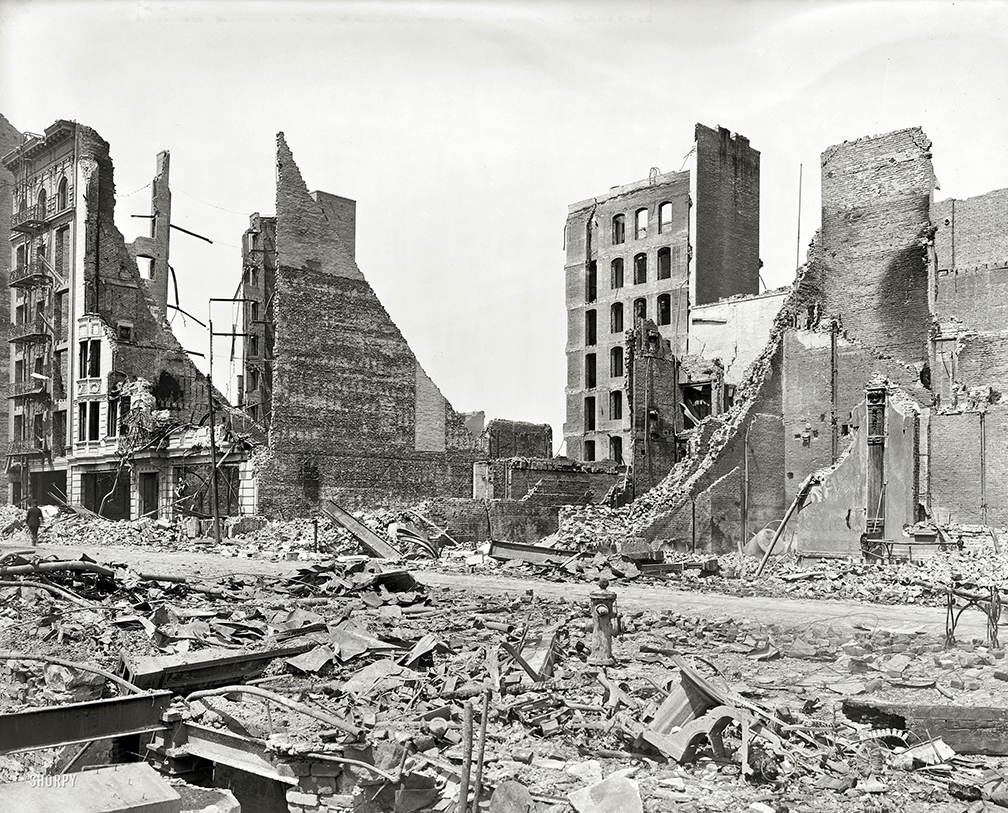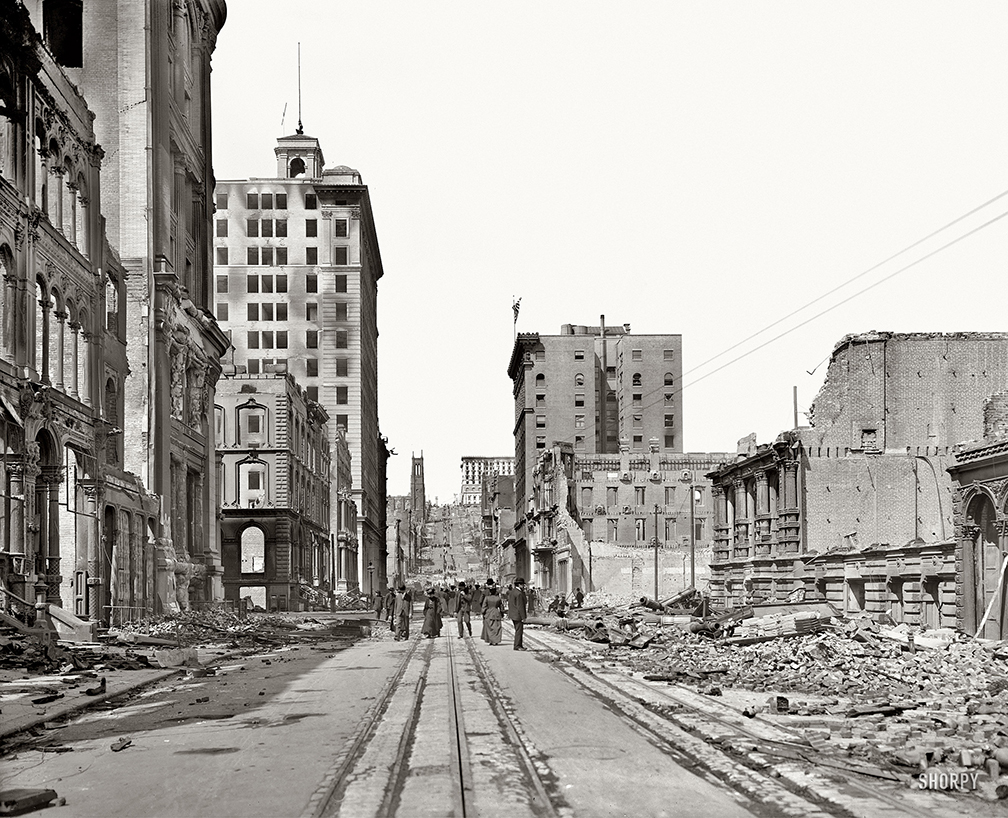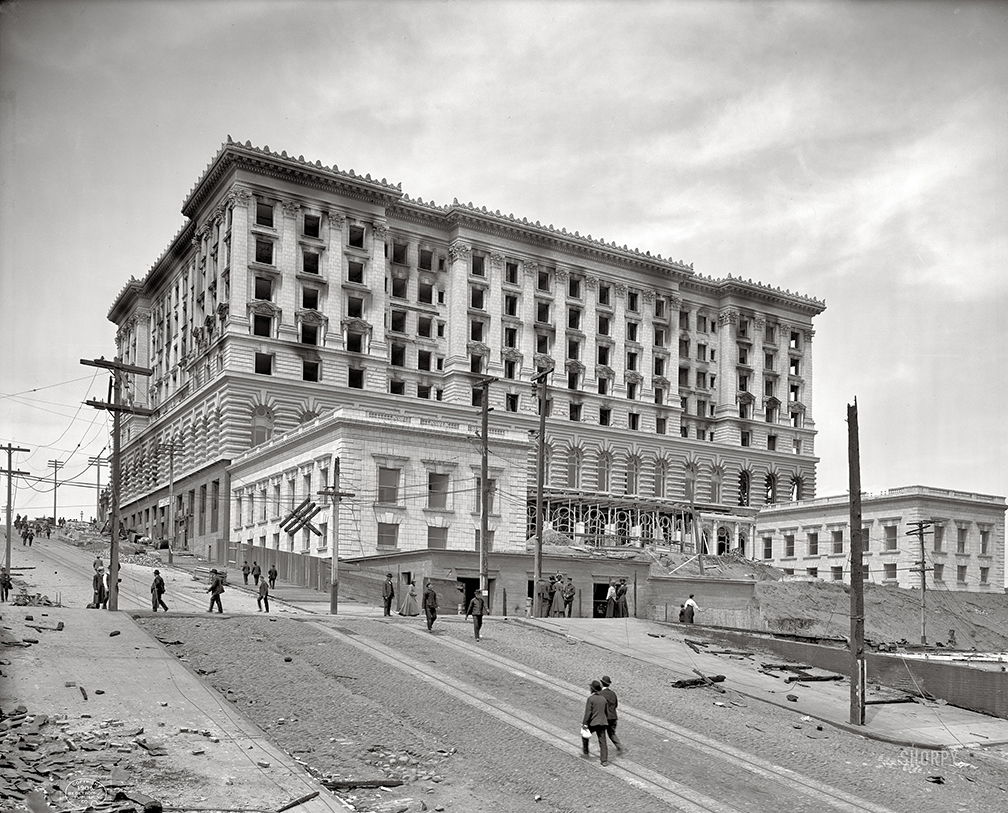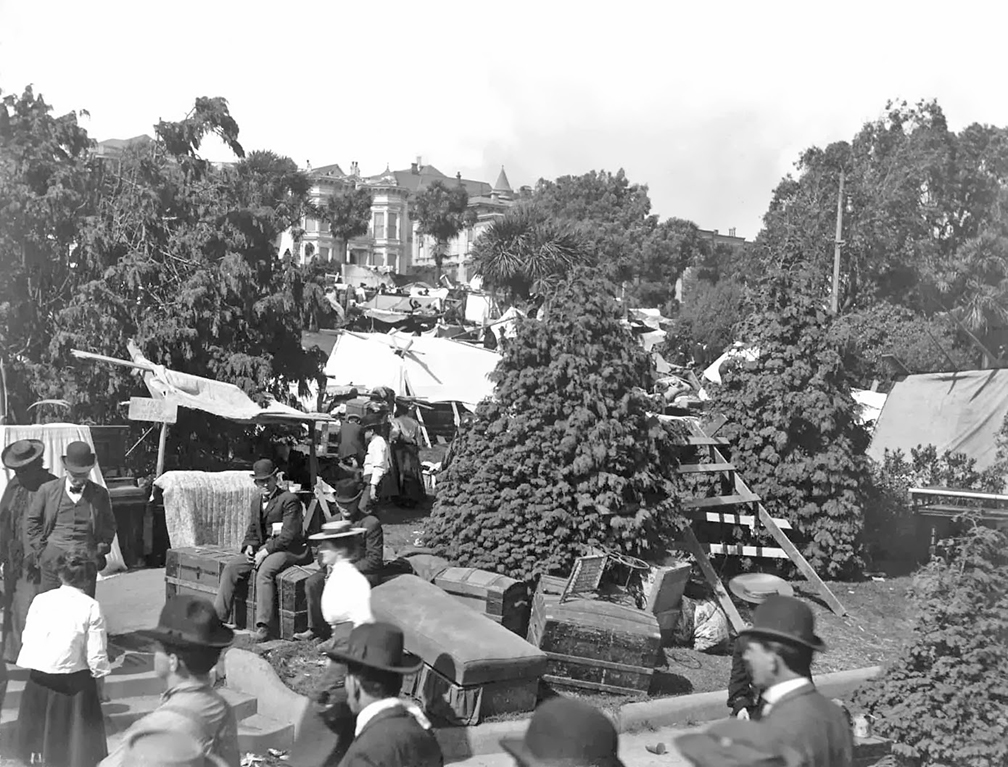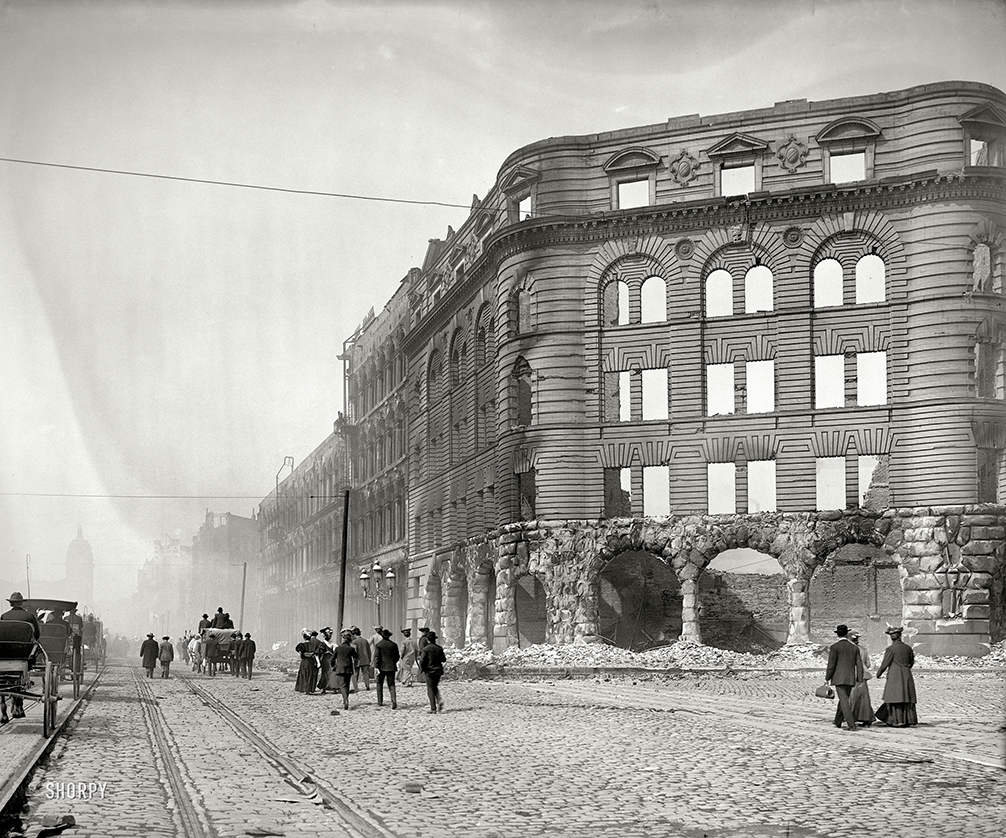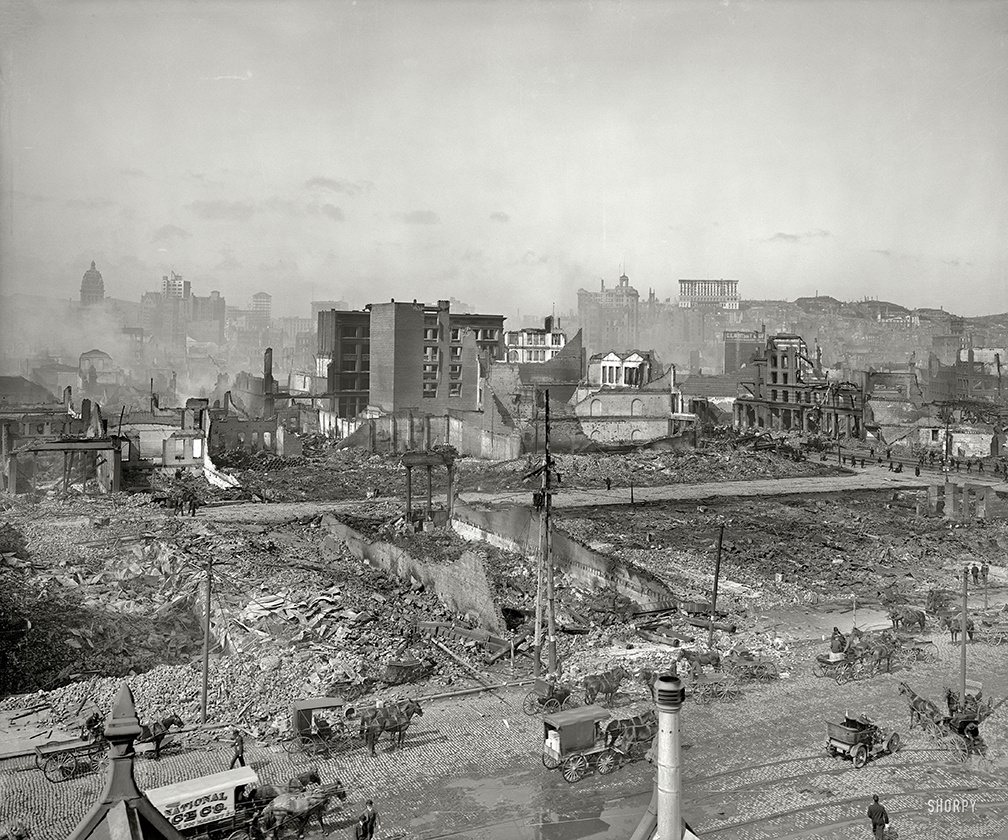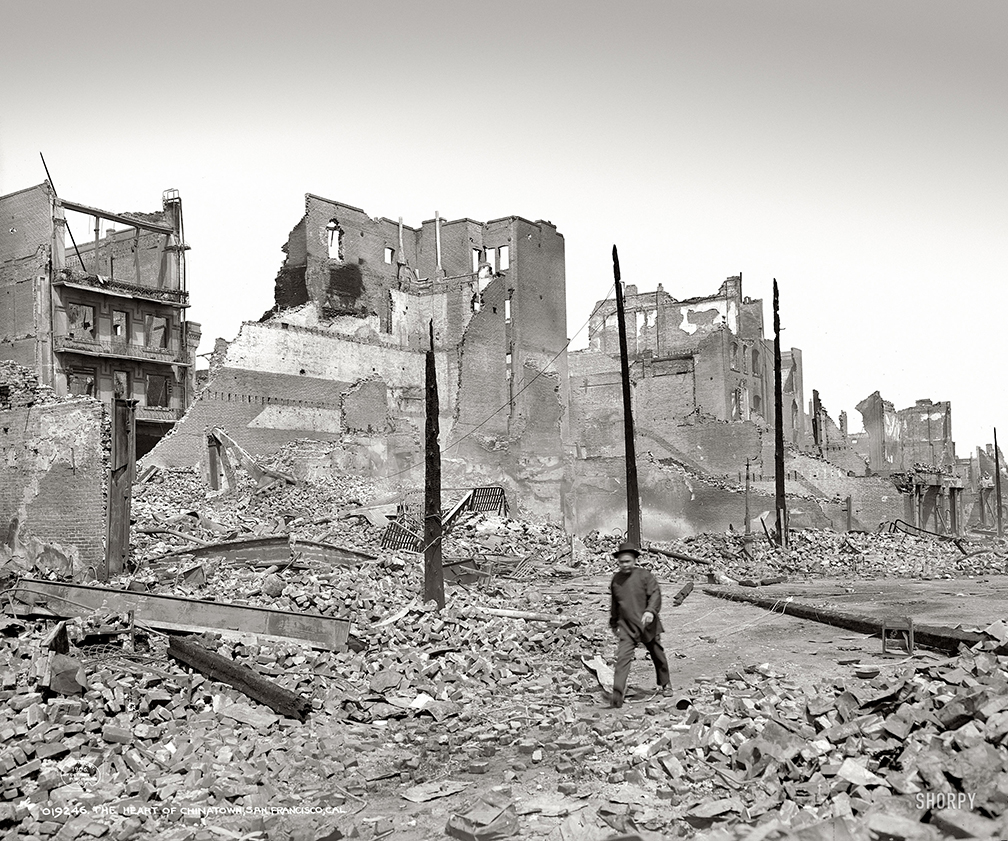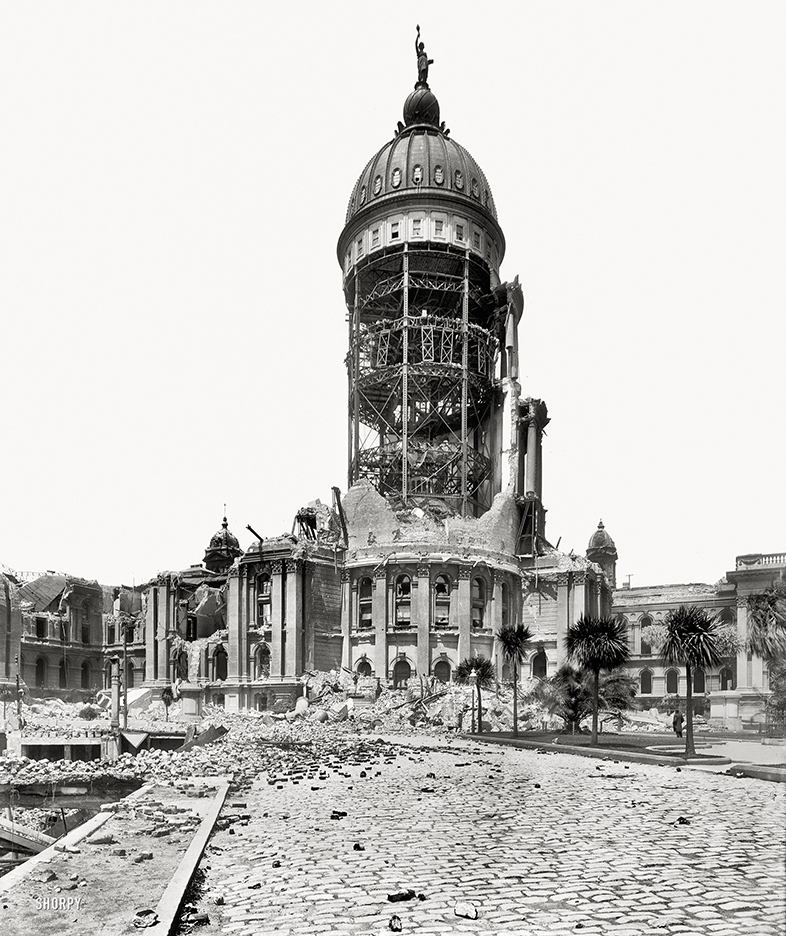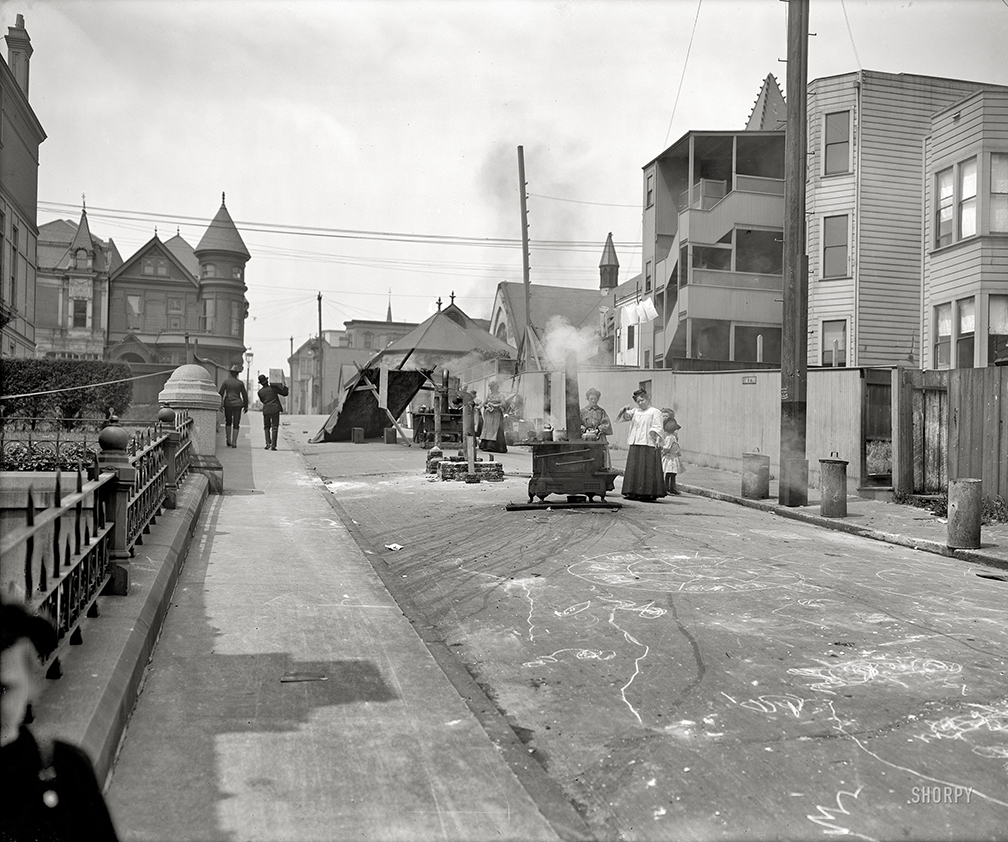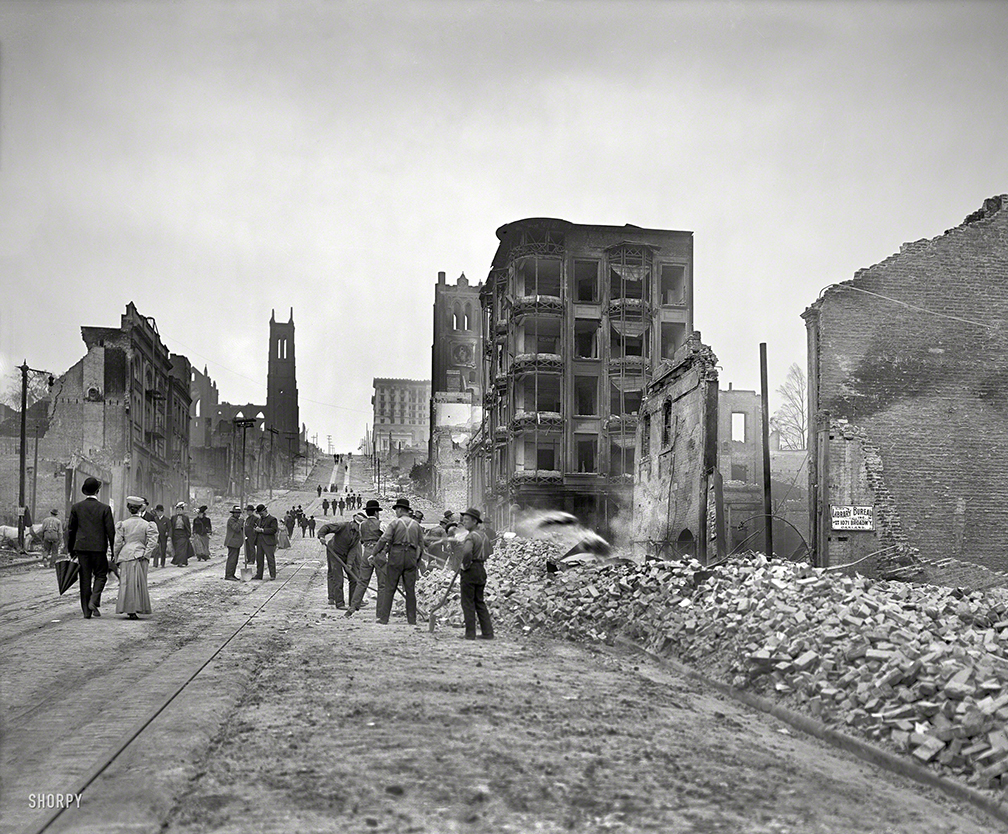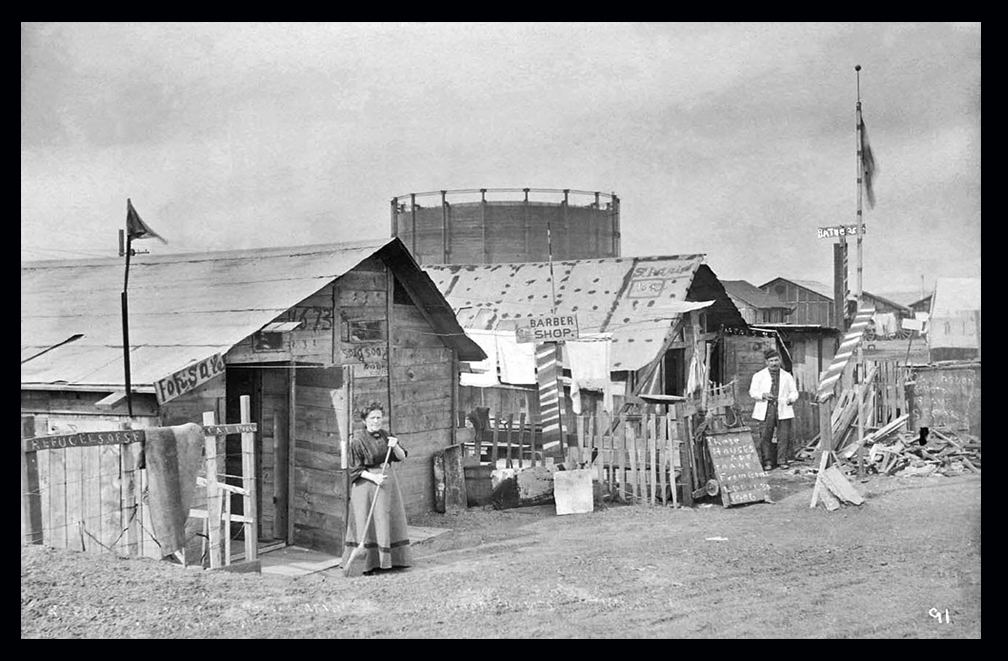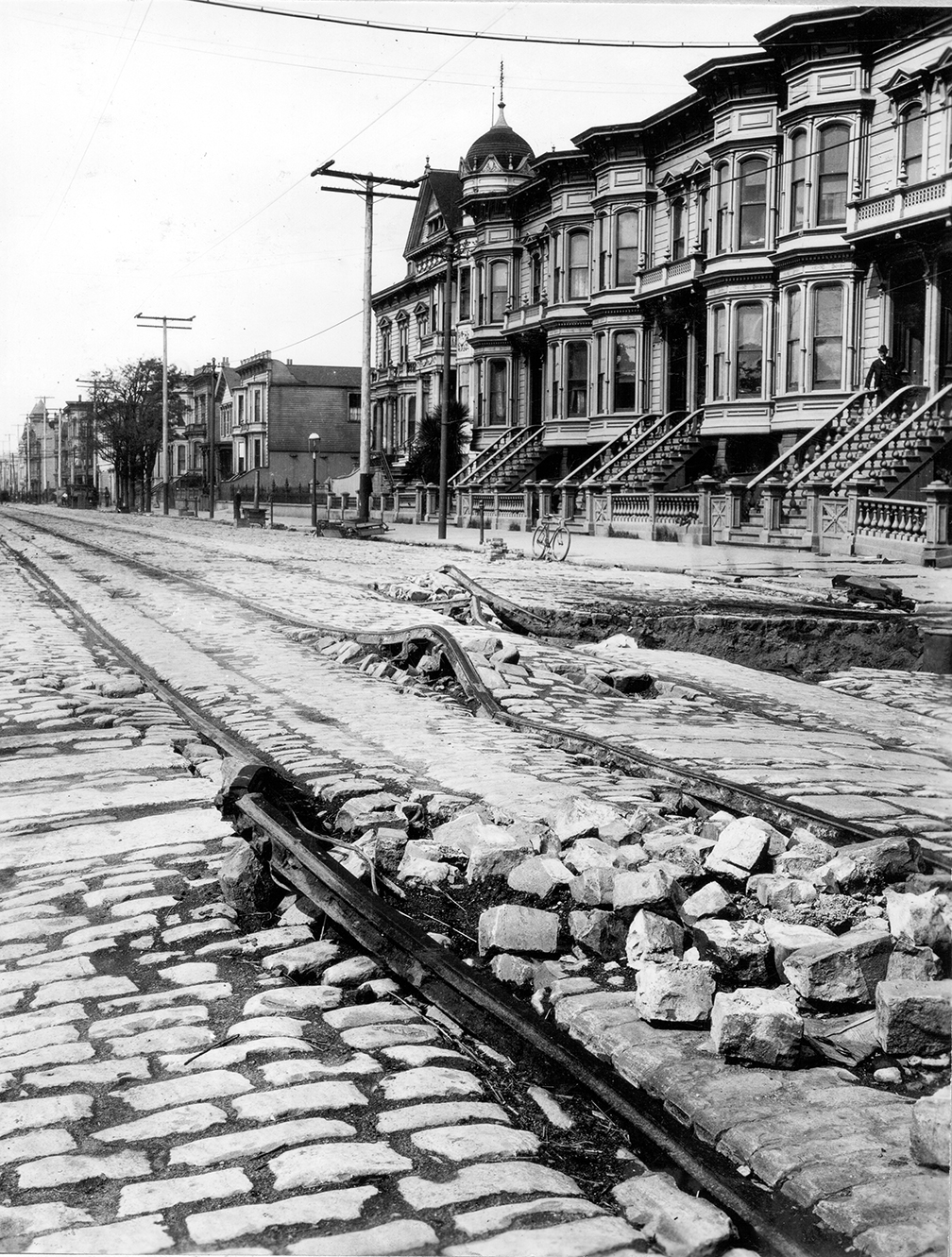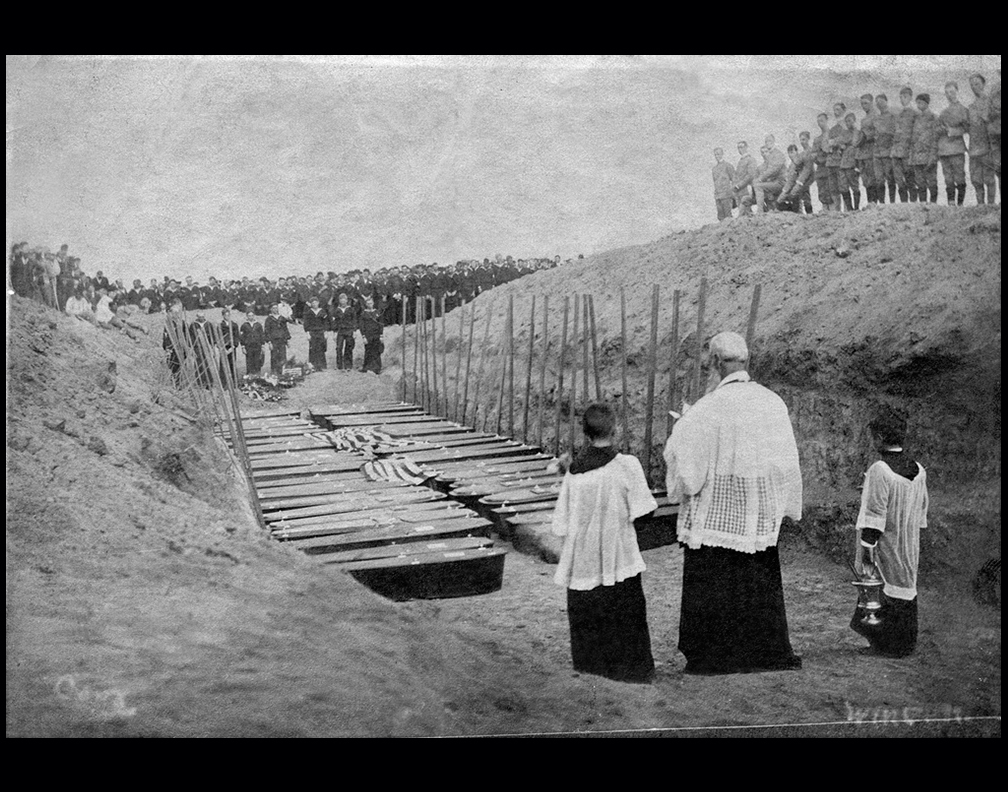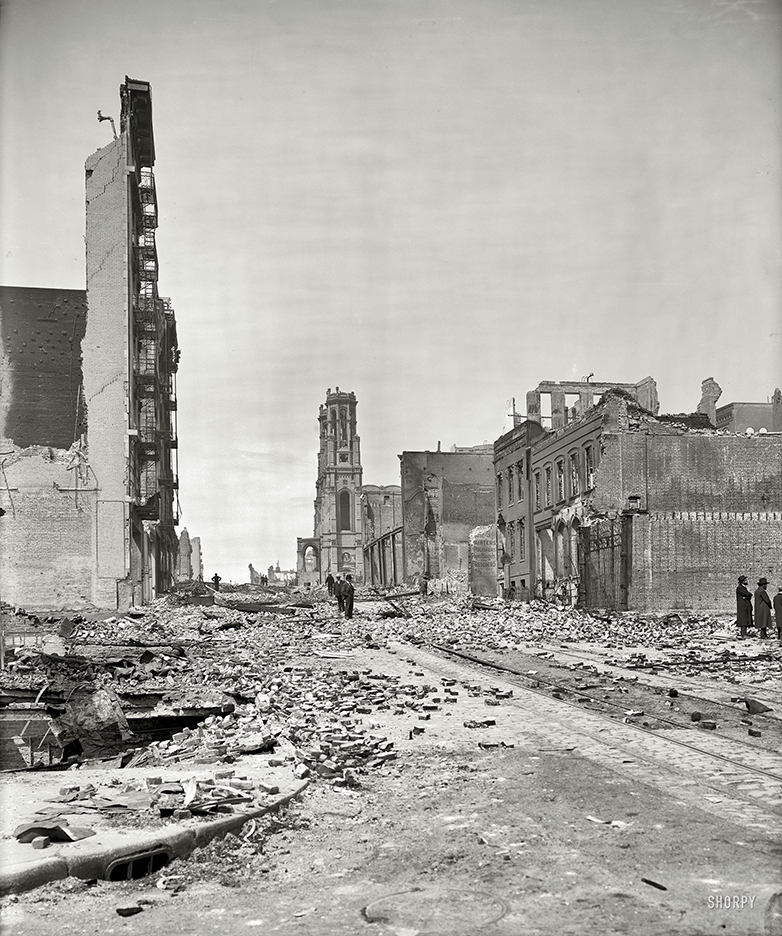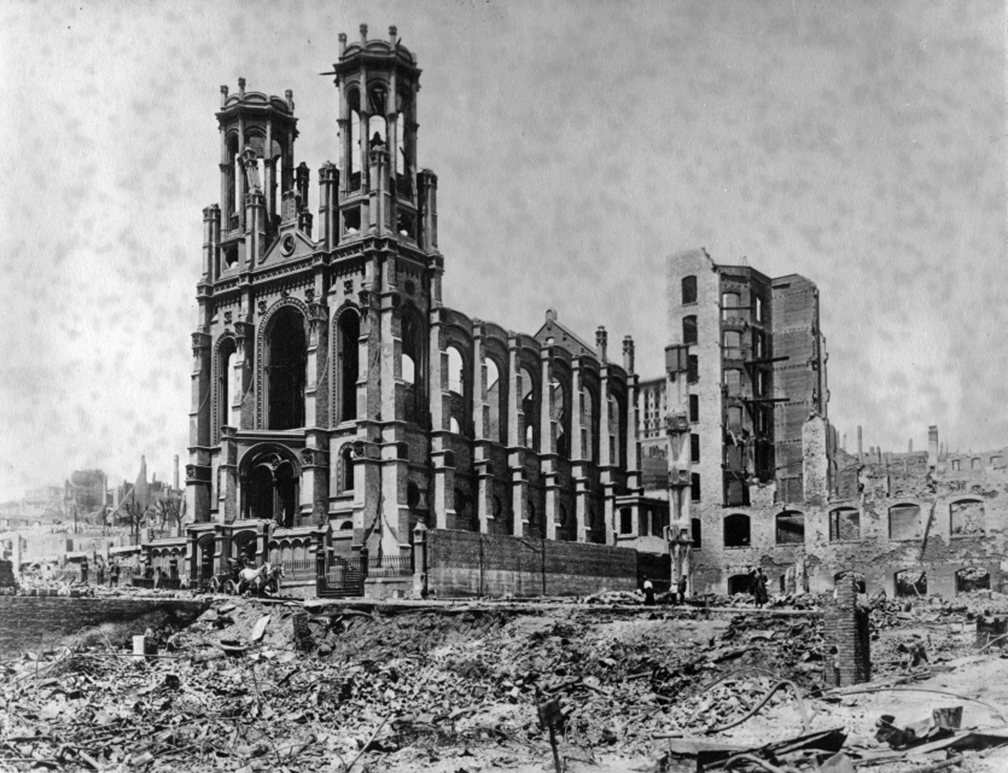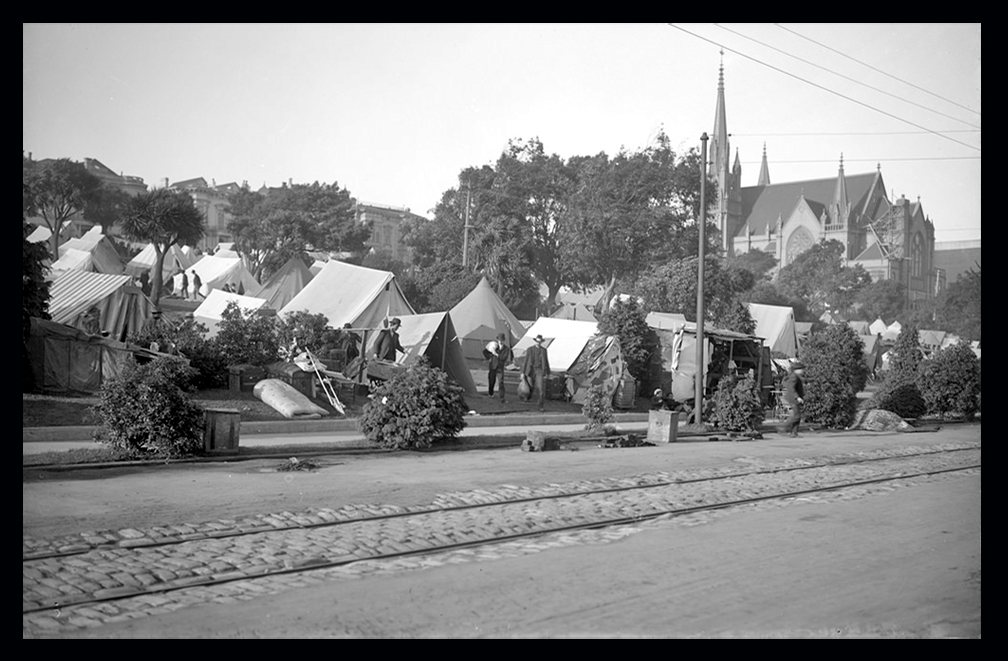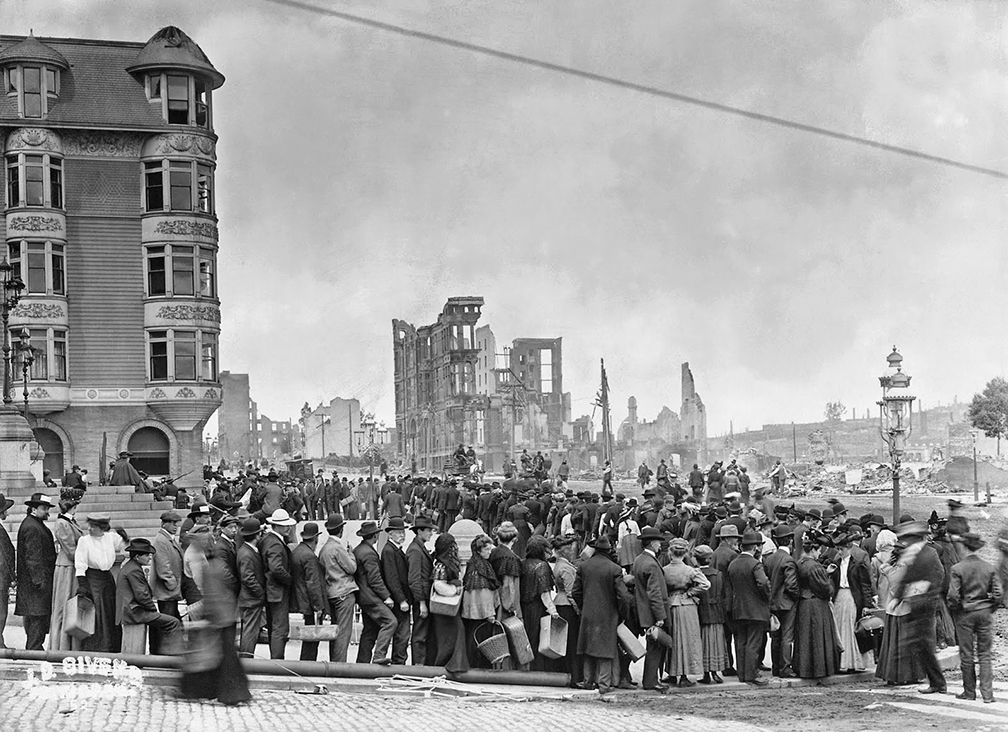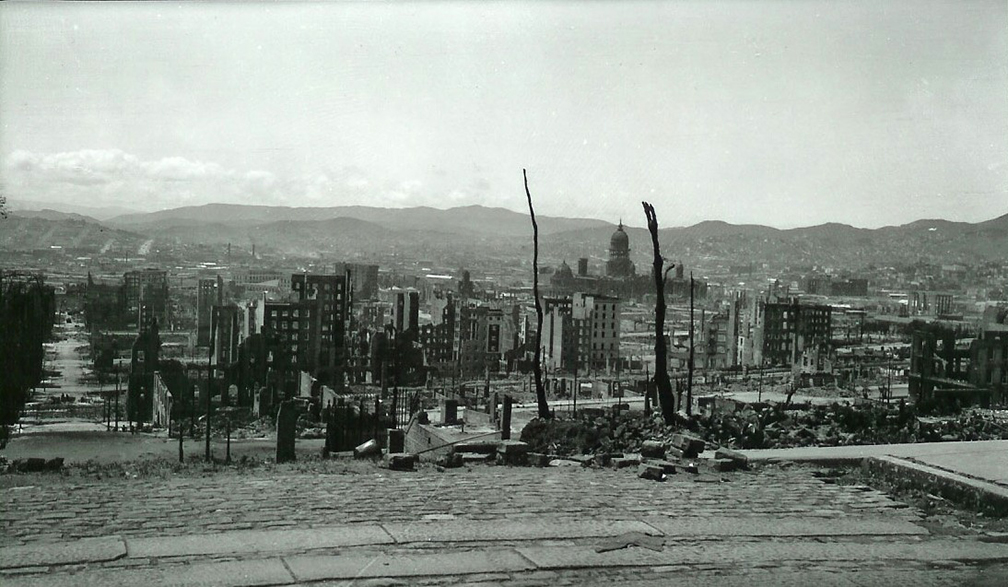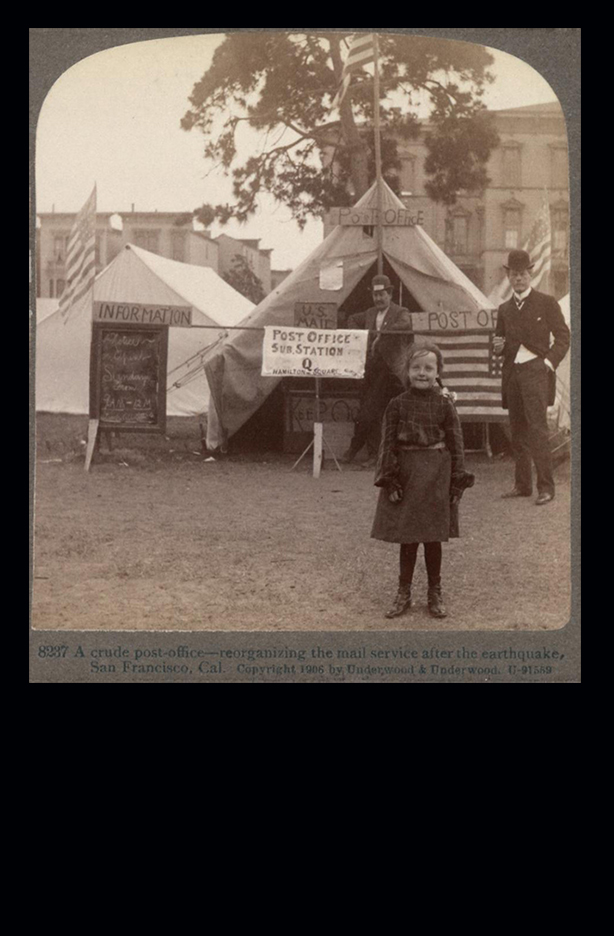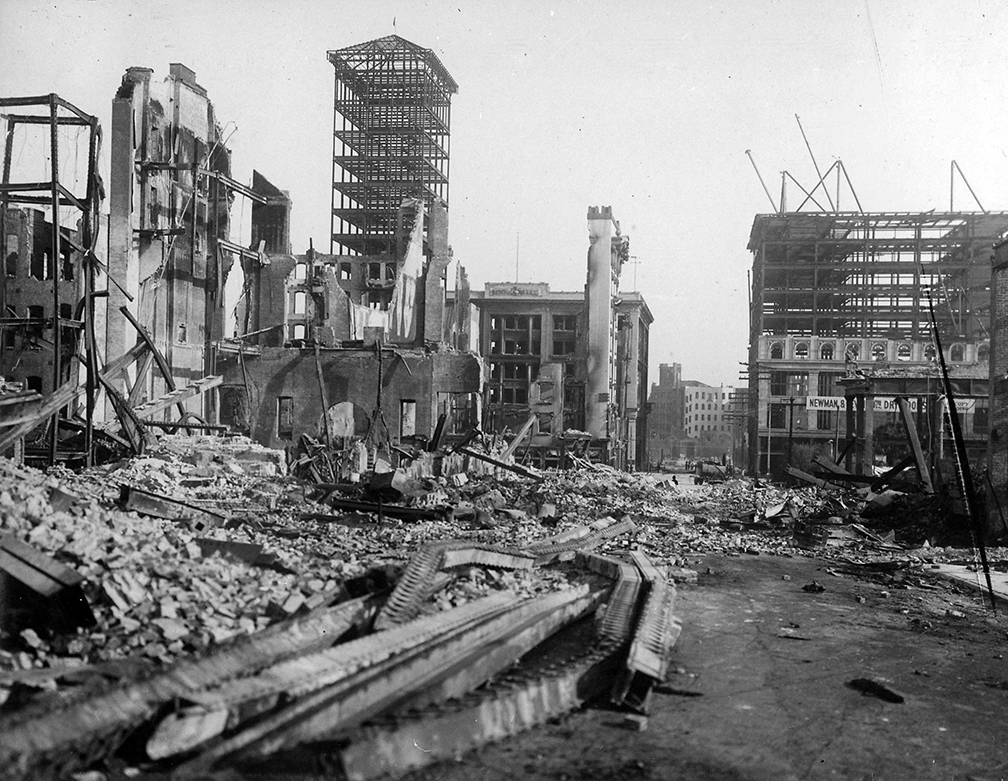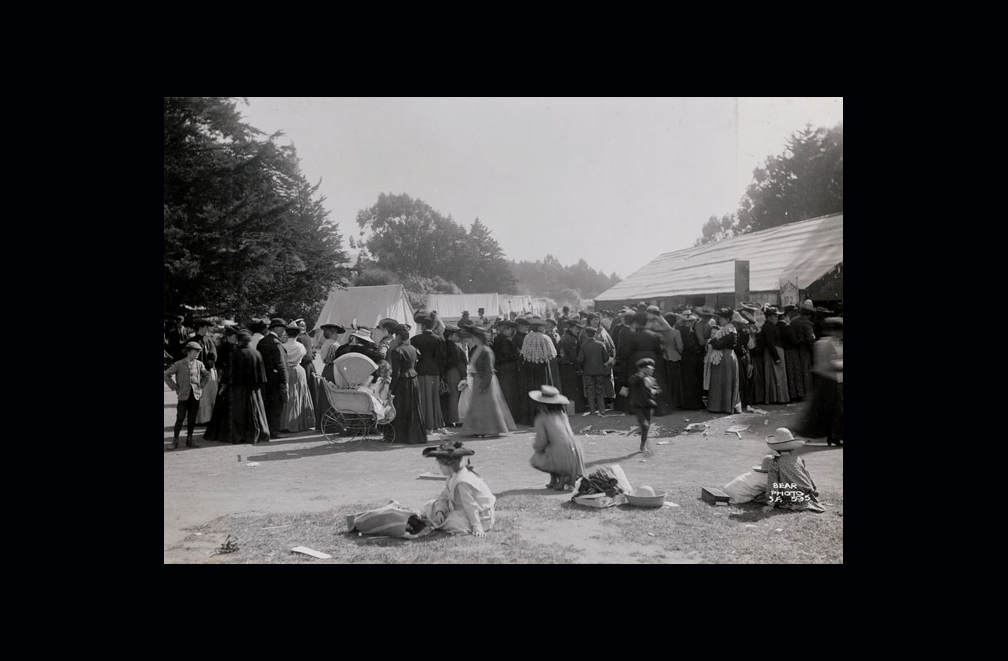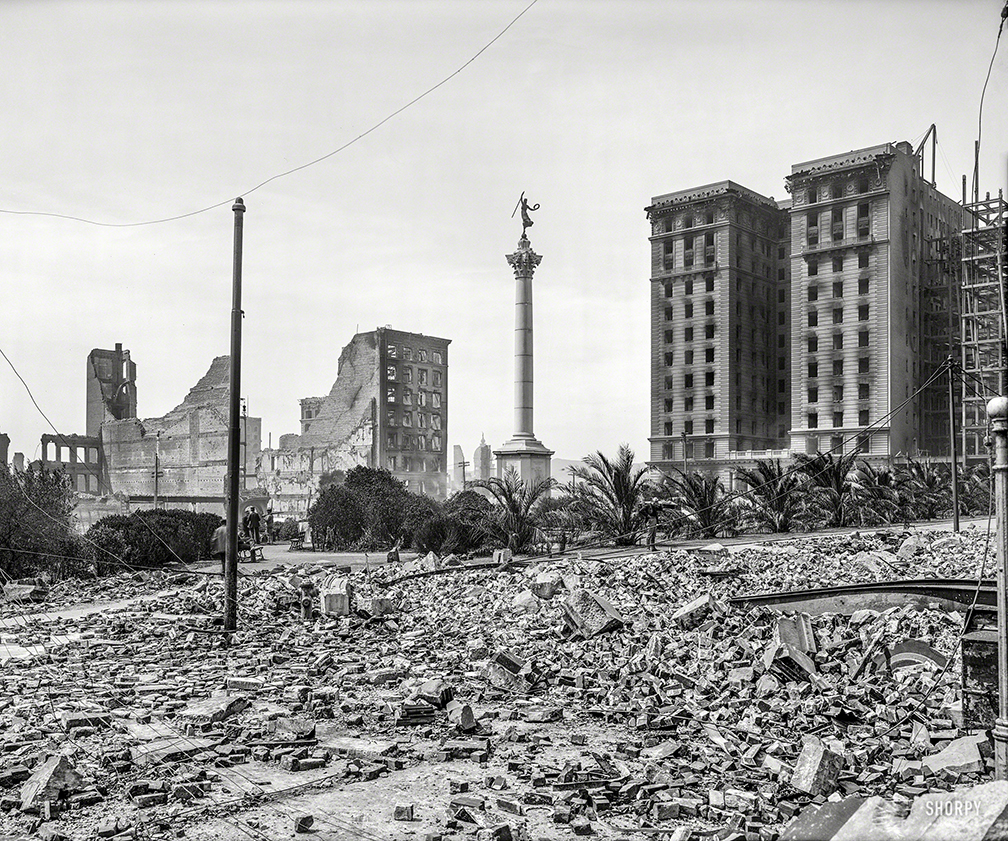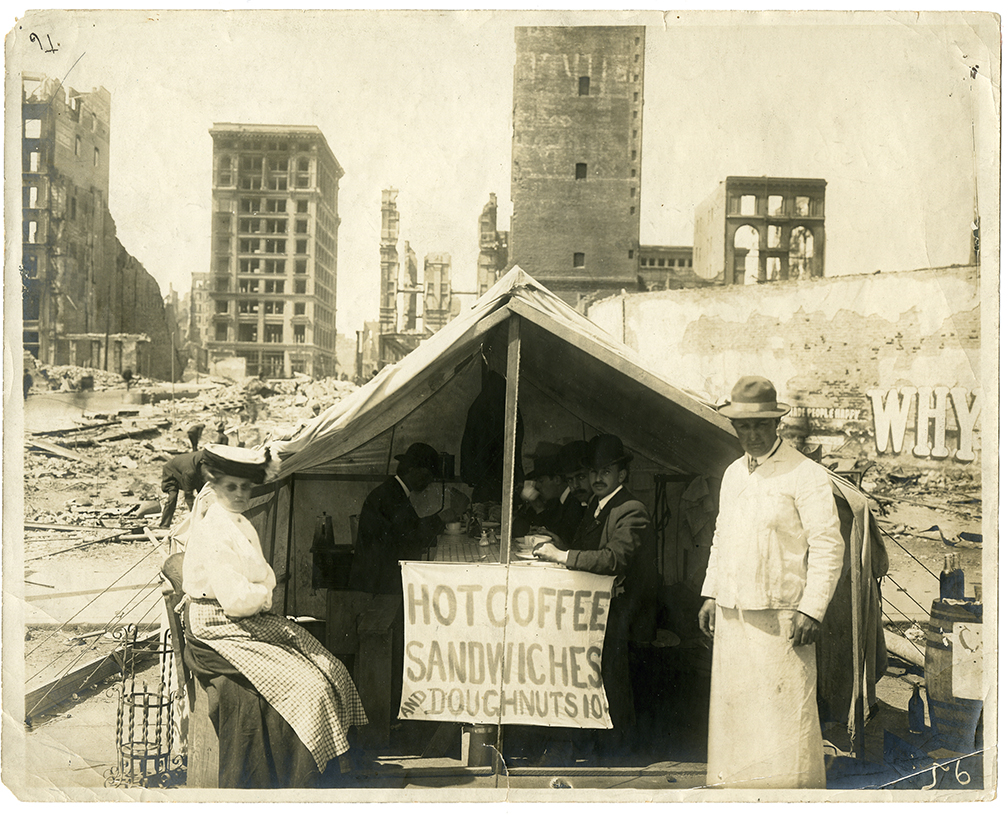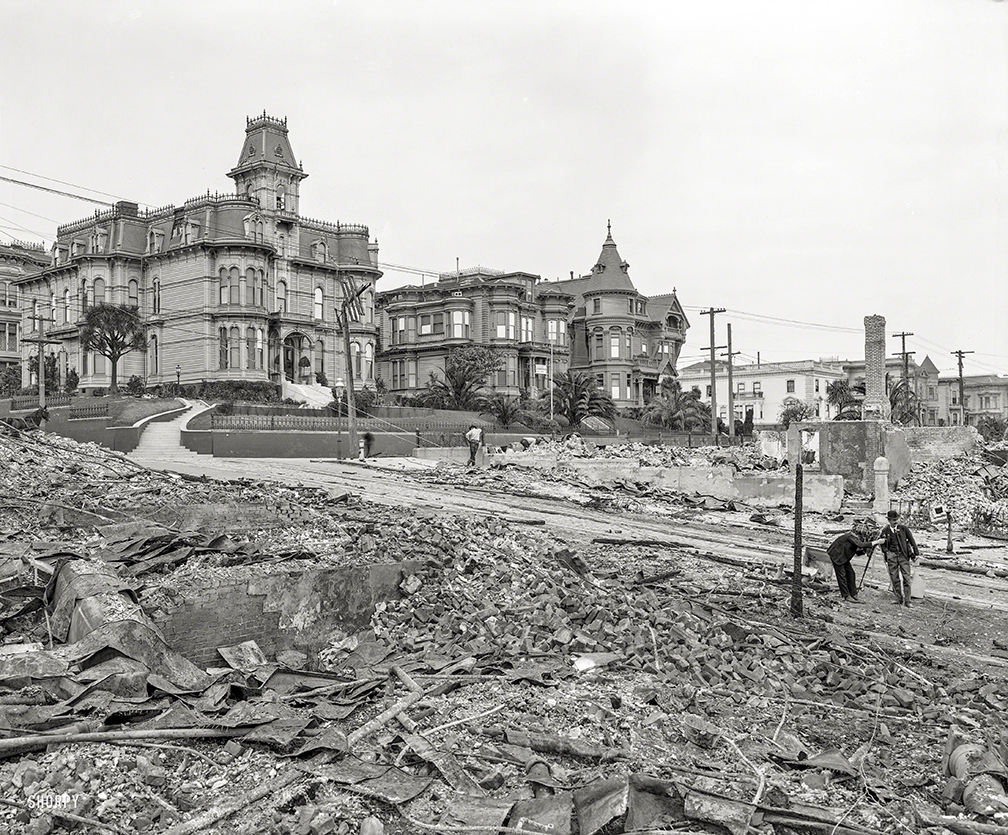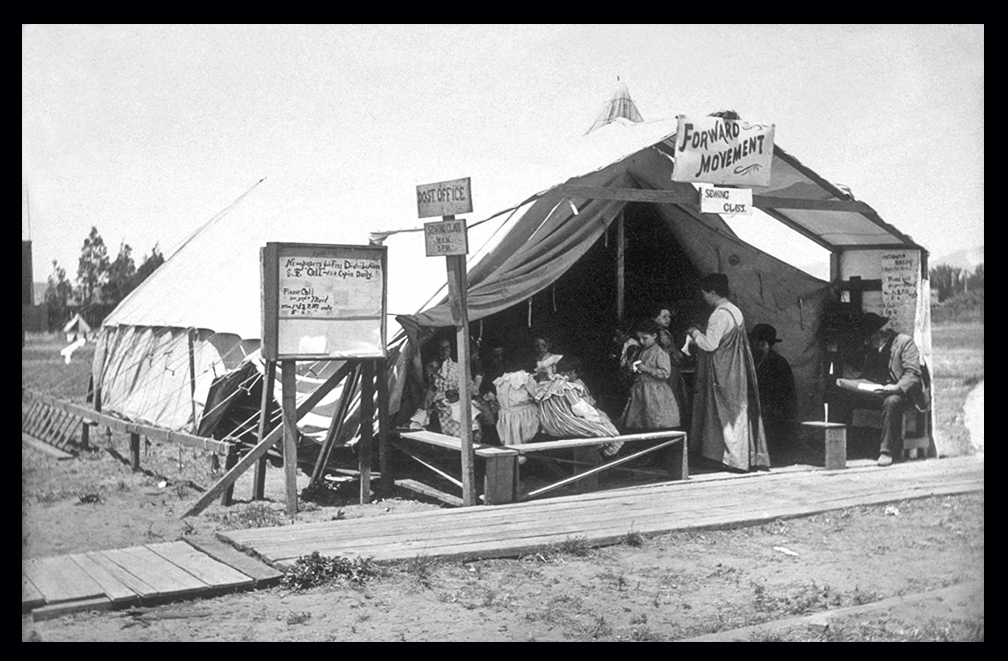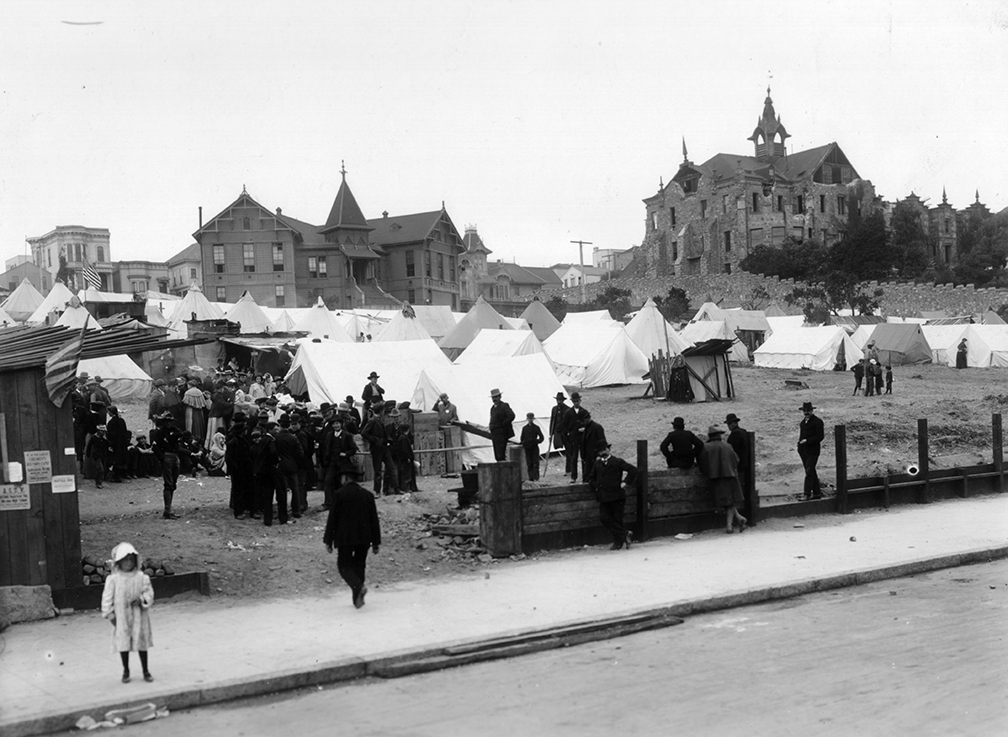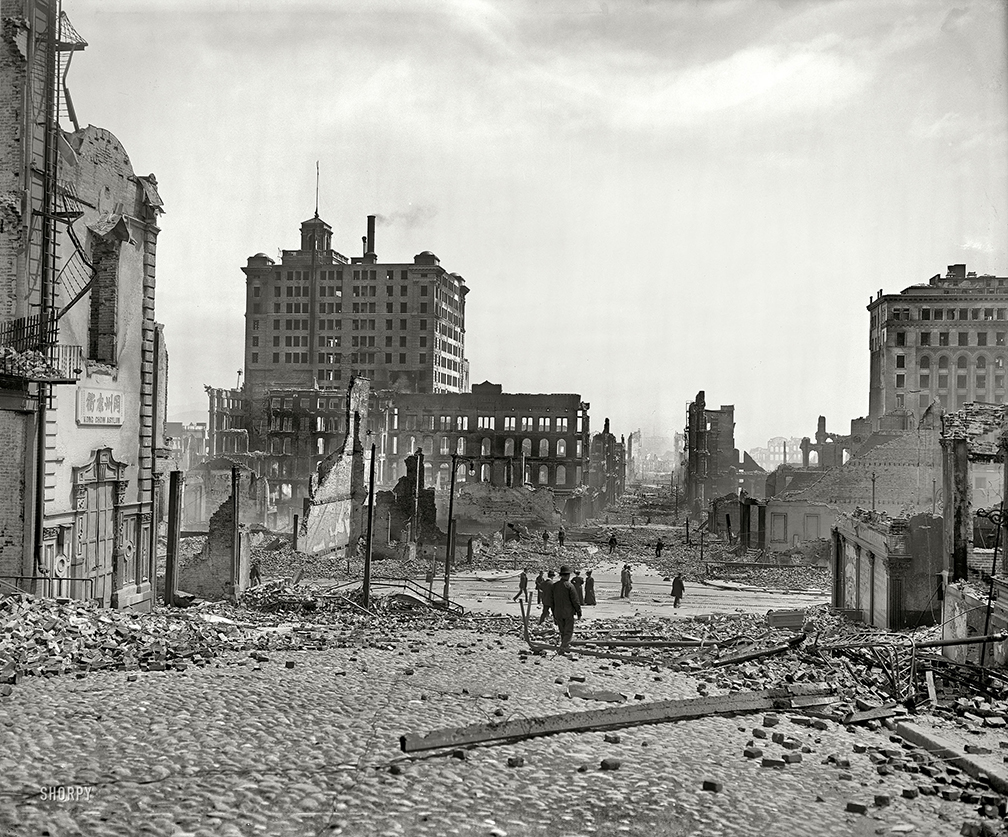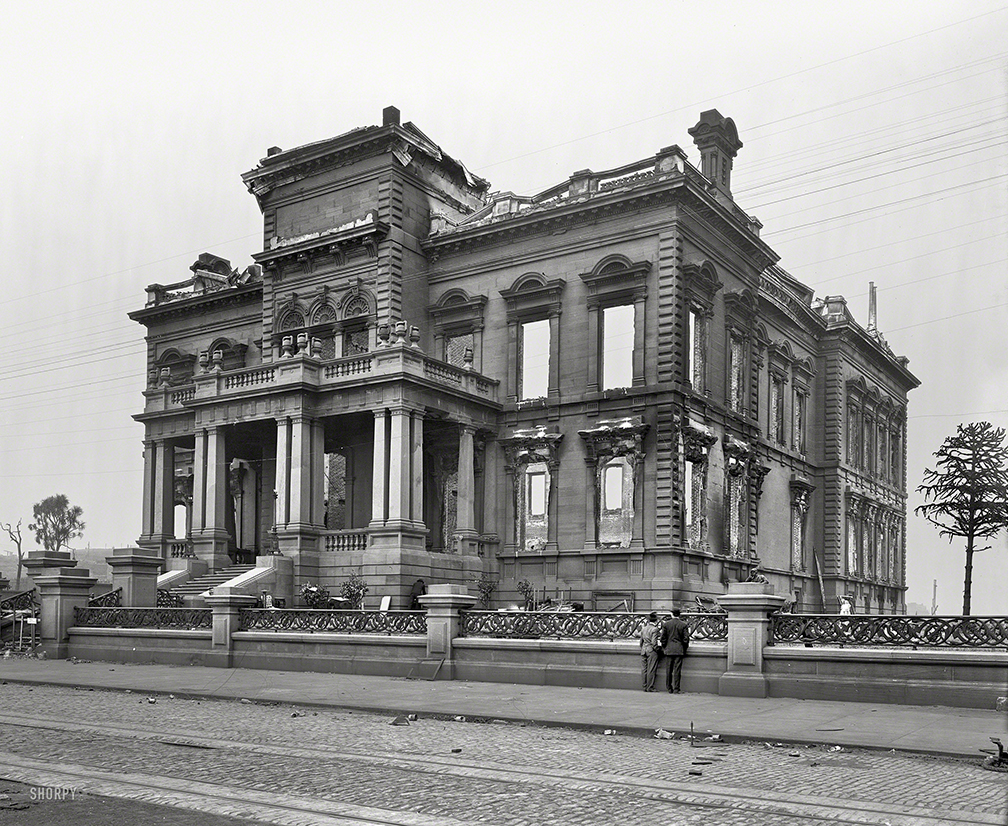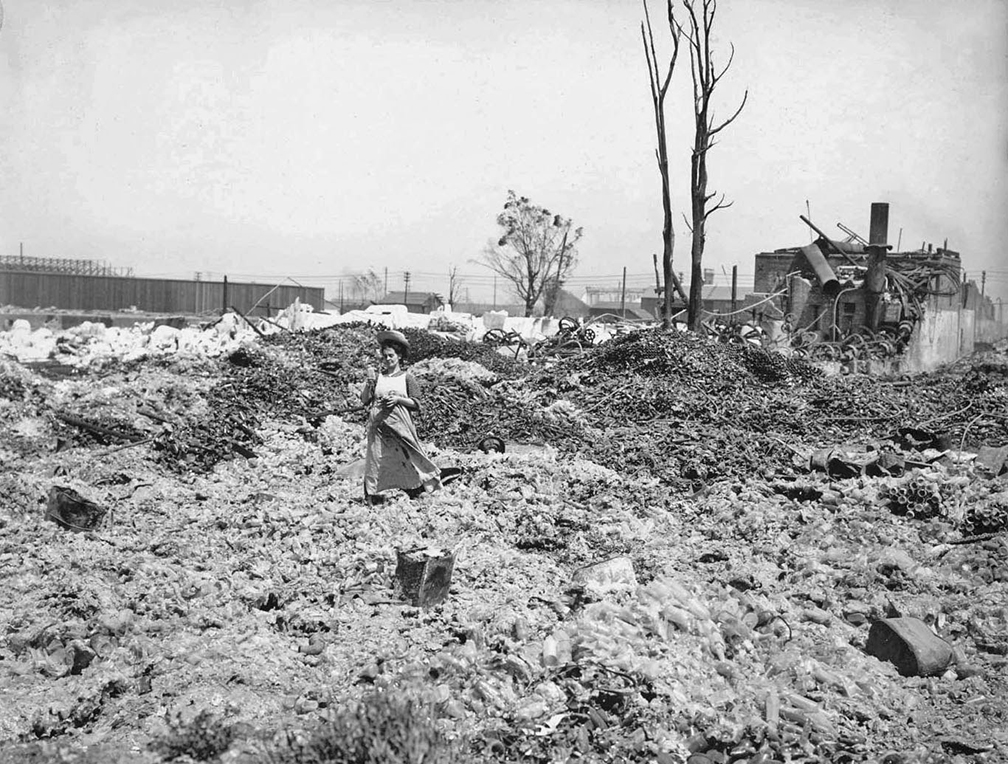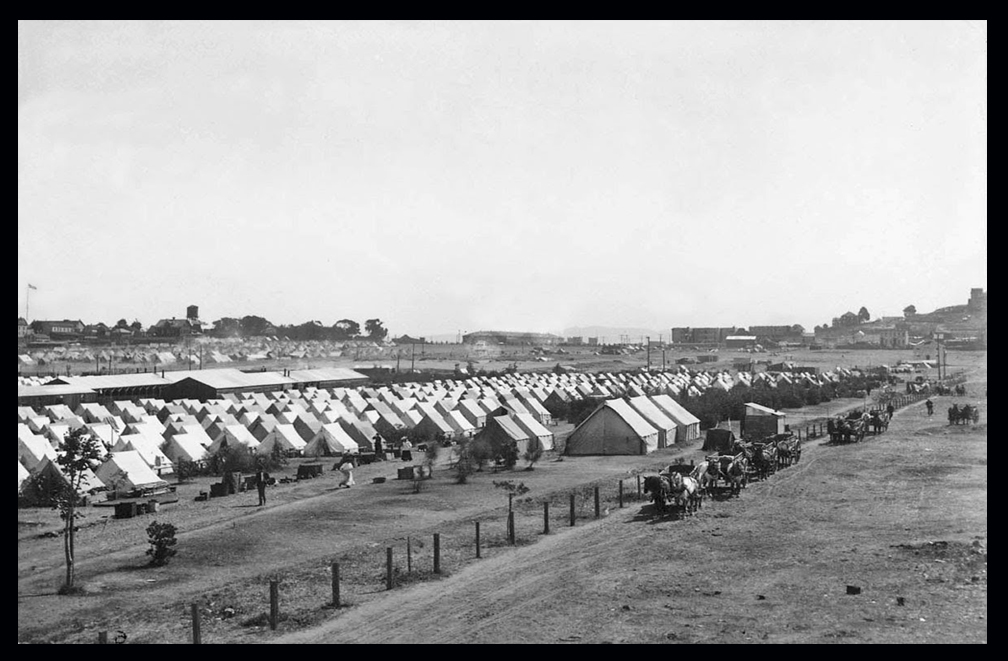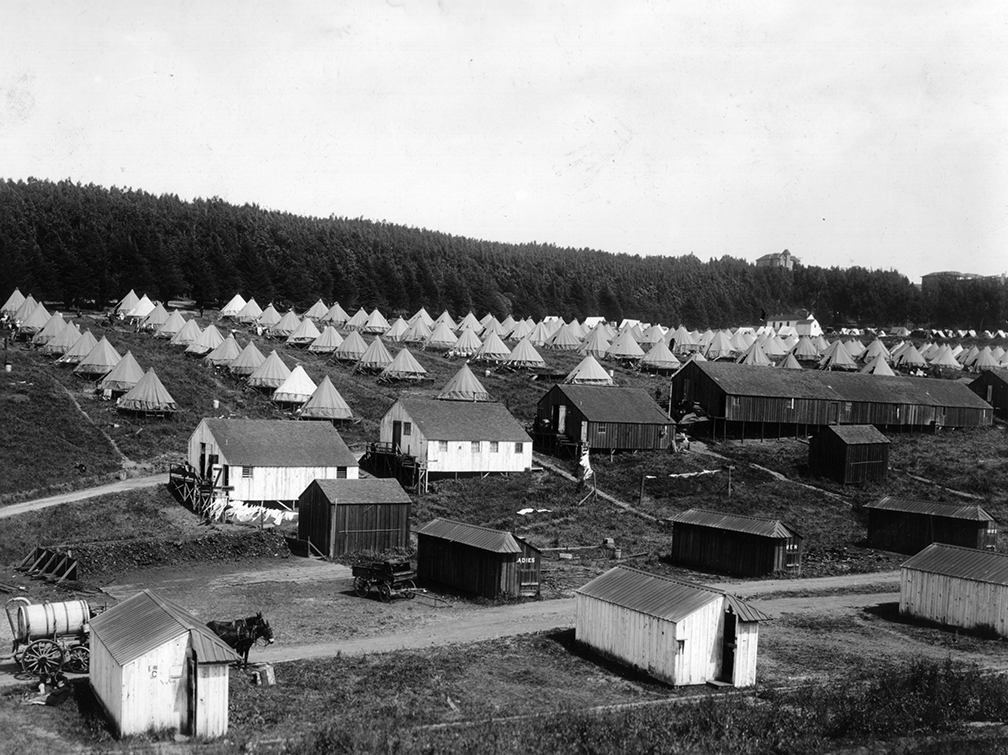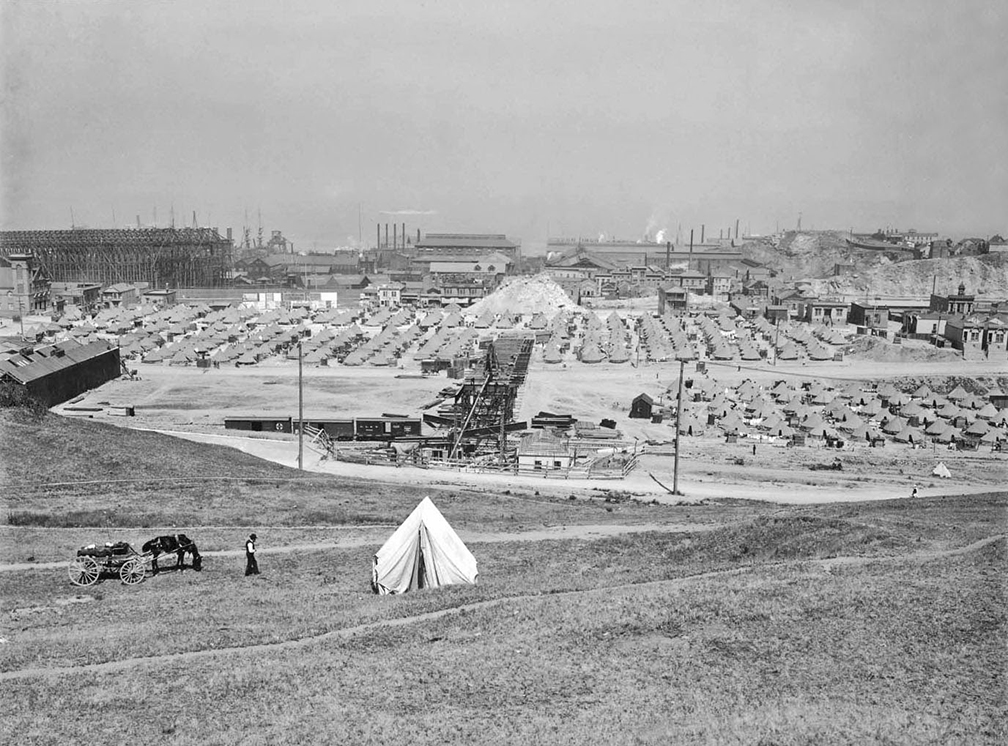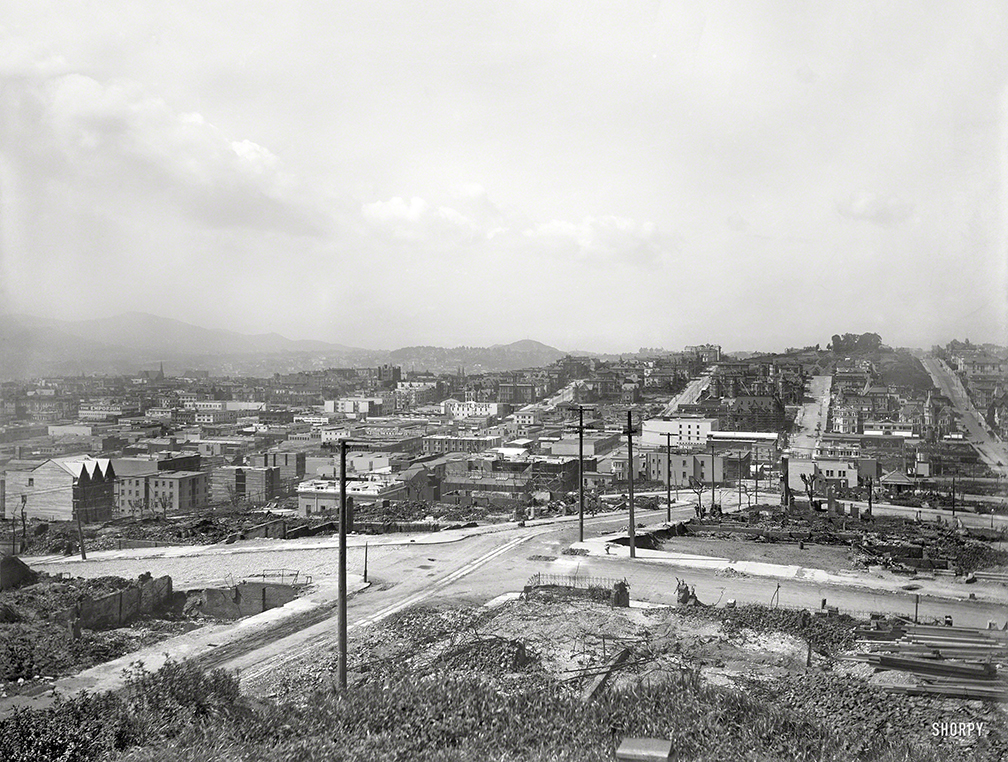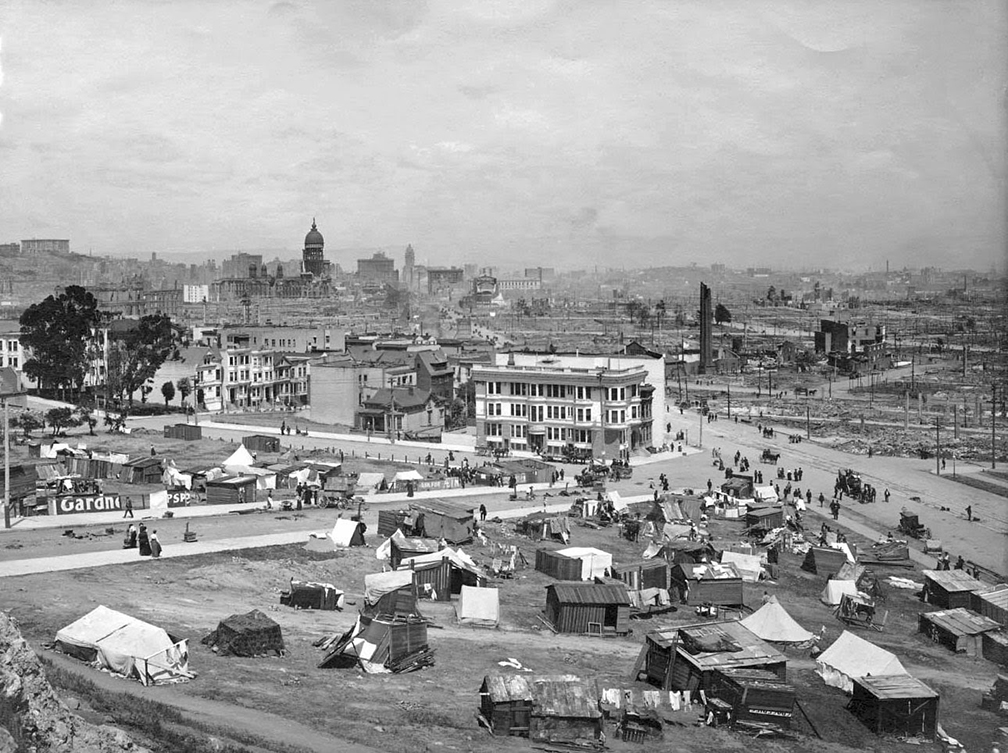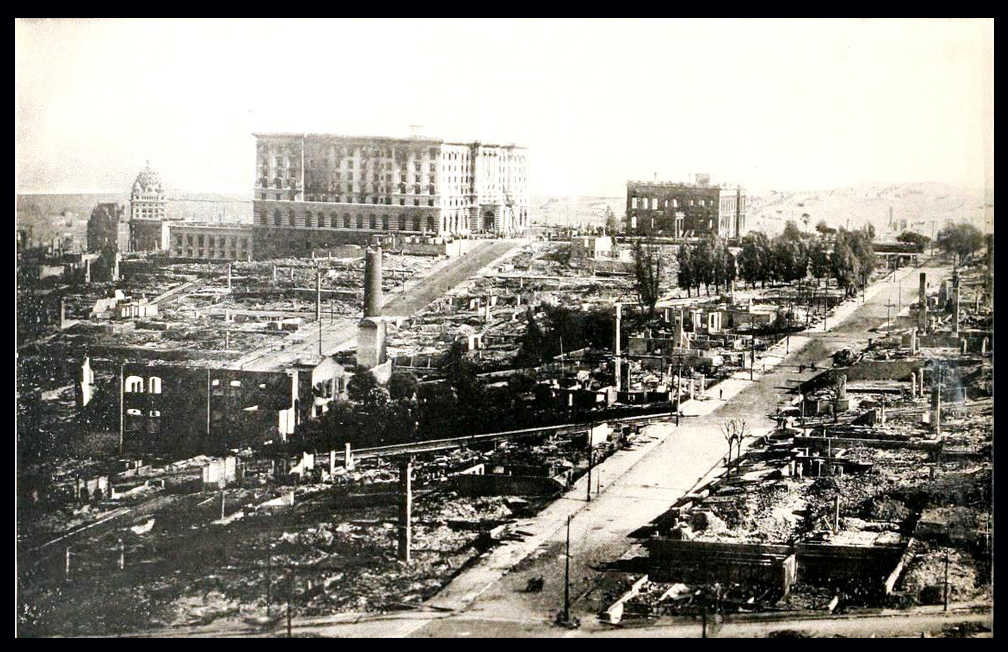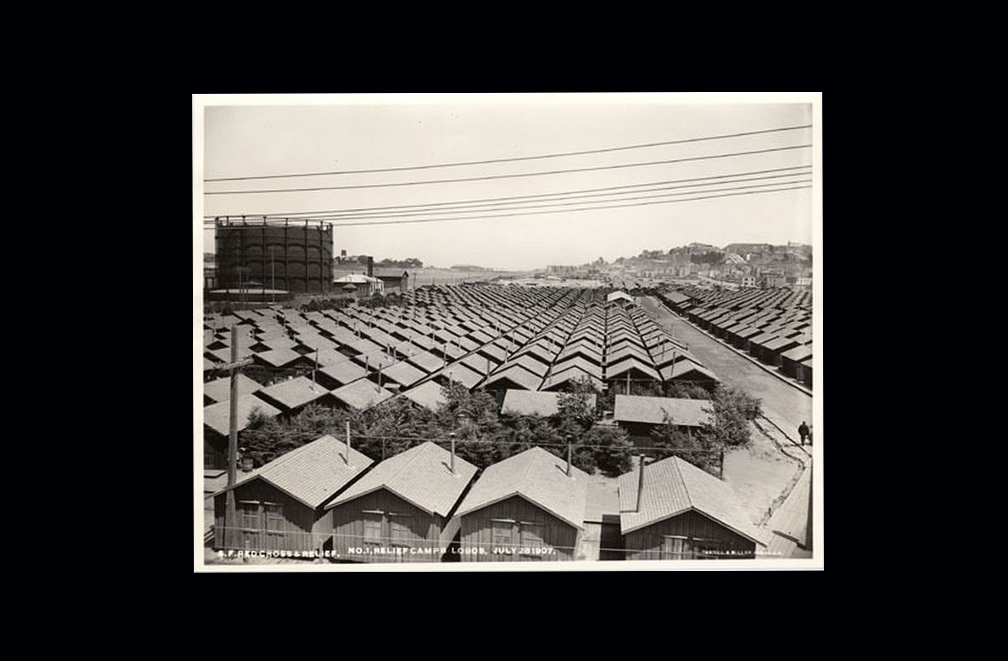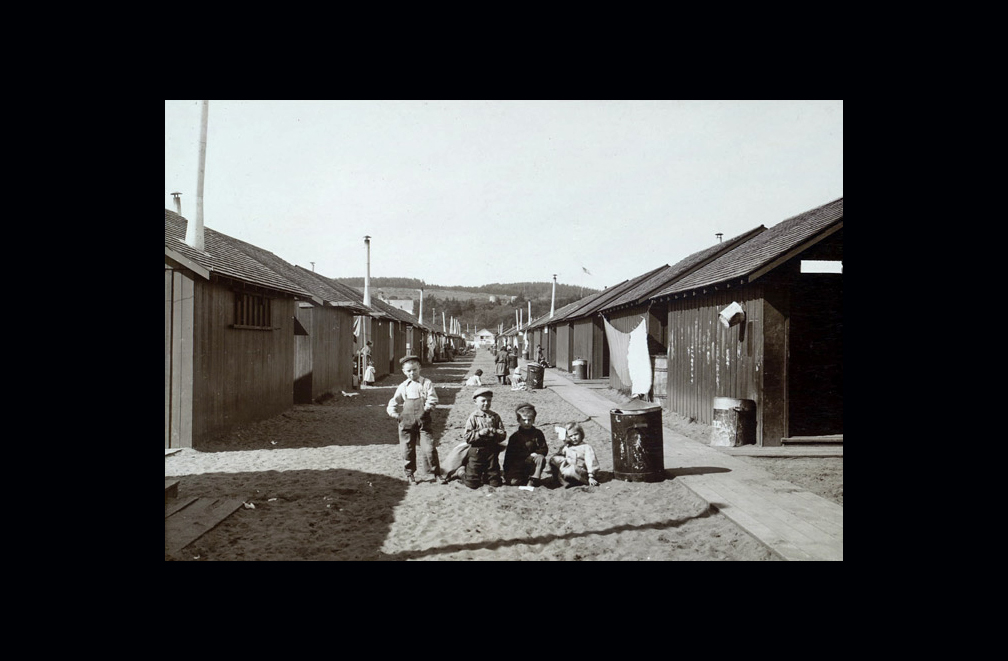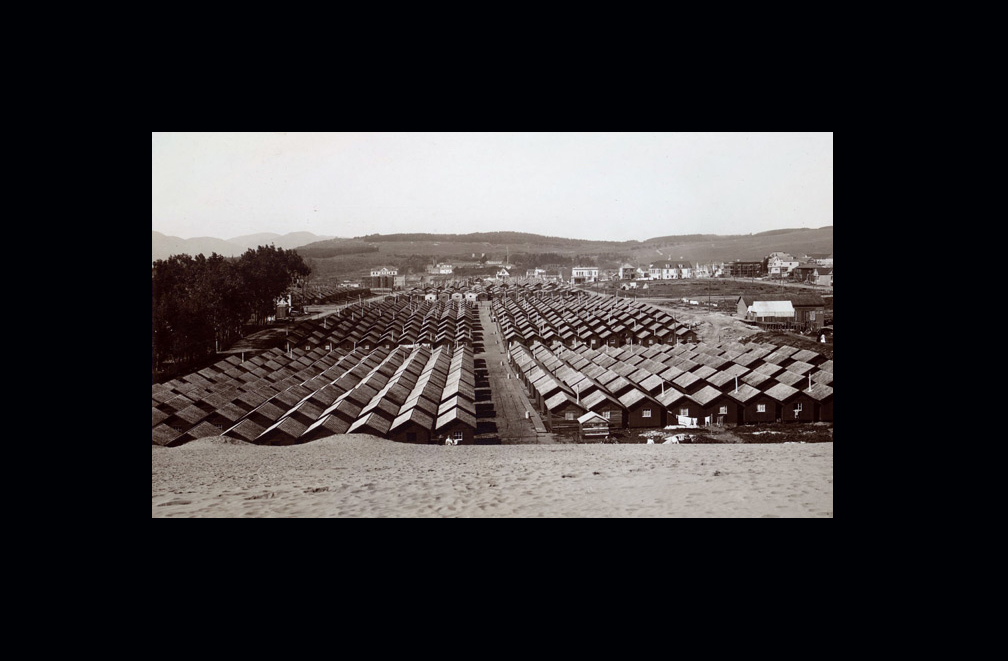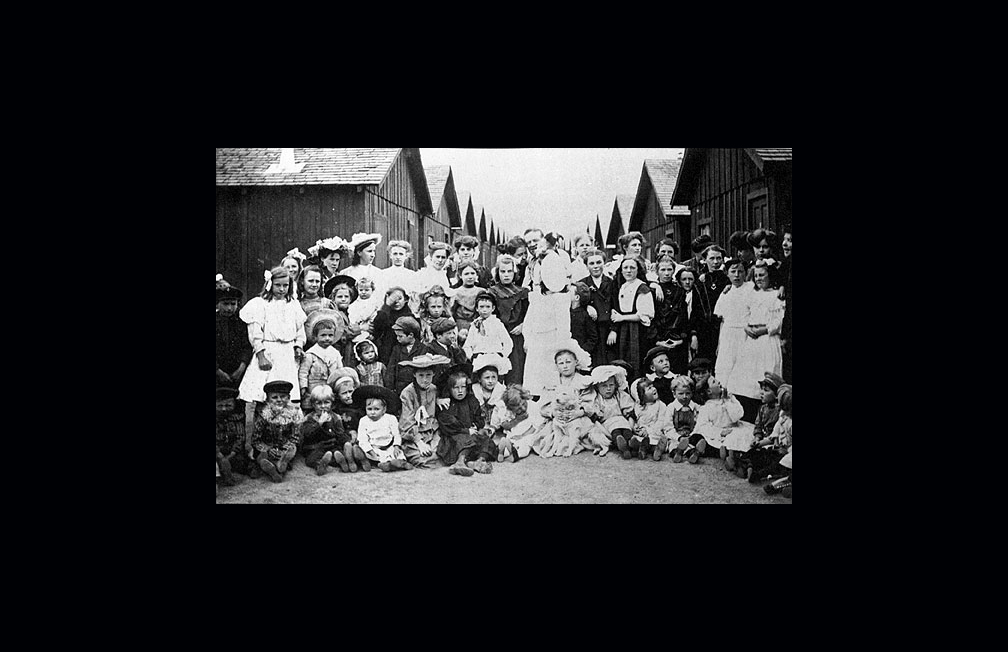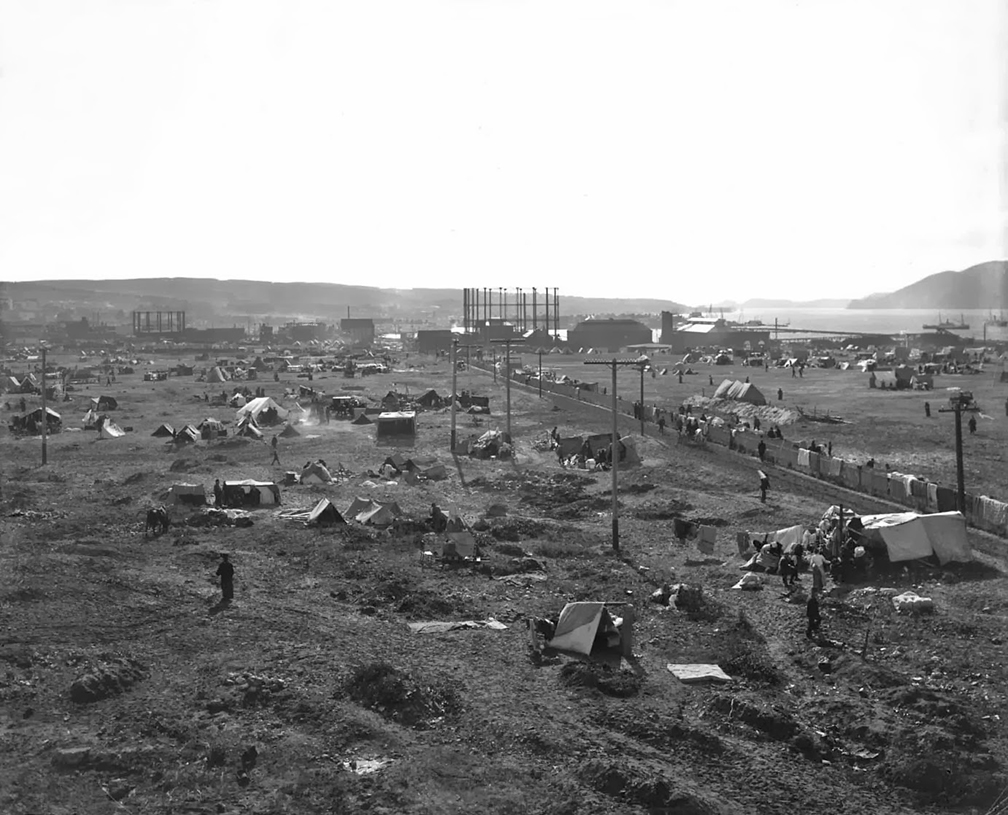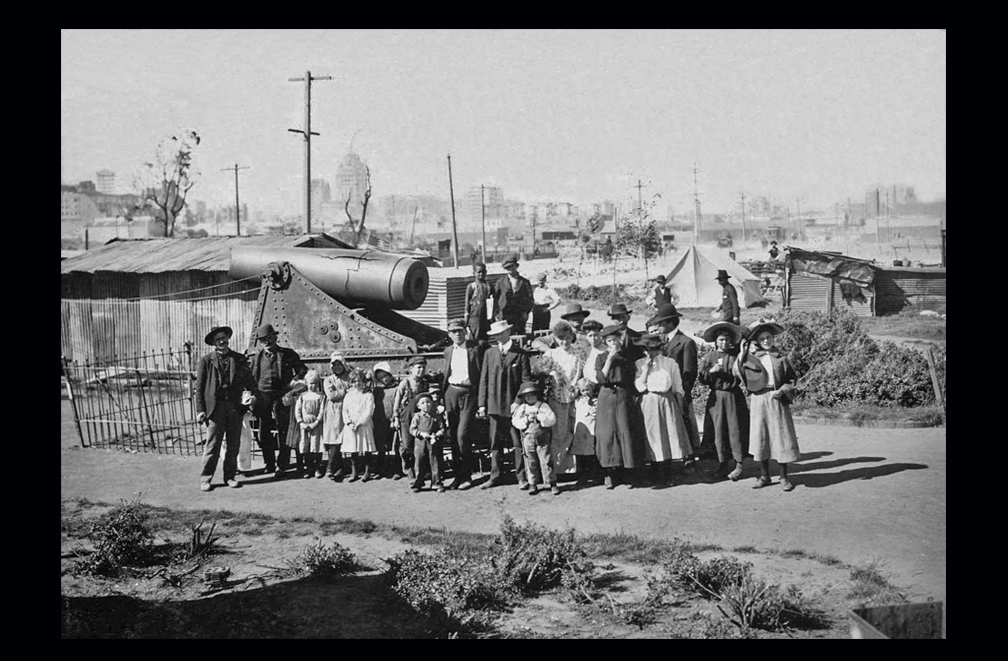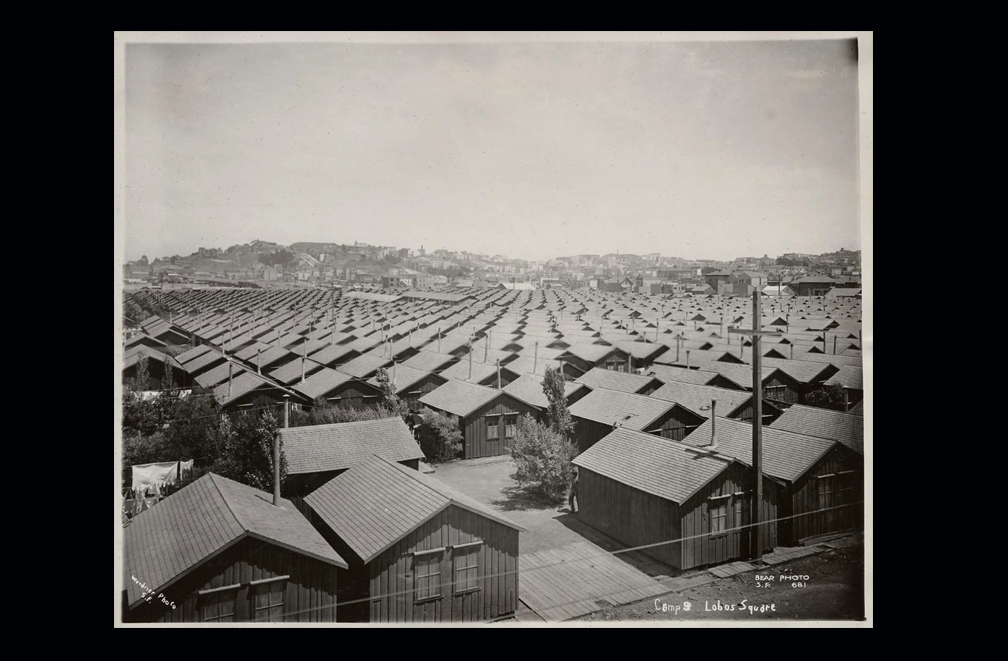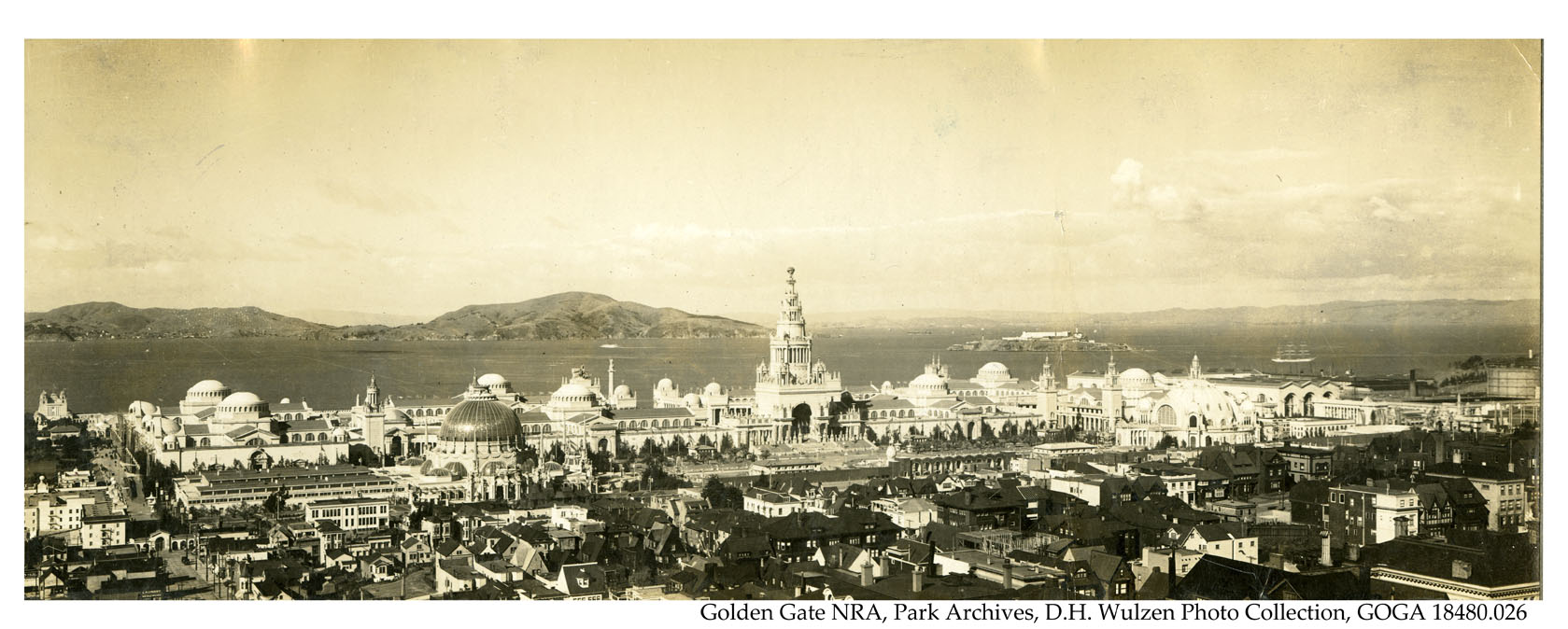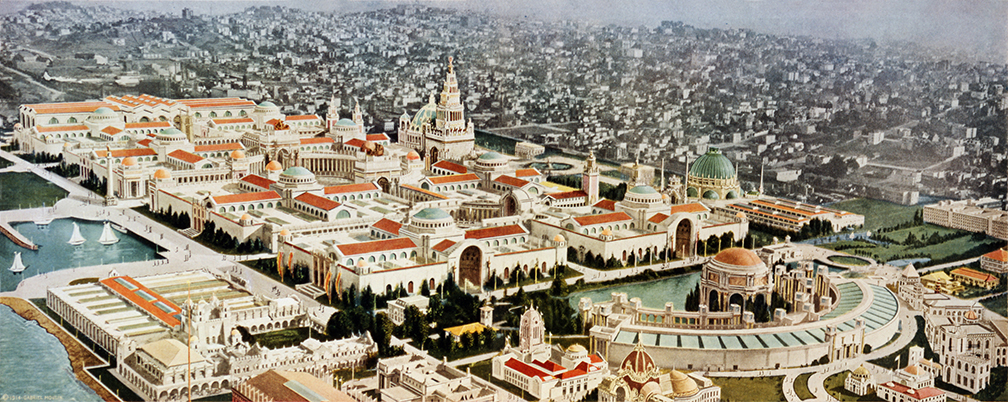RON HENGGELER |
April 18, 2016
The San Francisco Earthquake and Fire in 1906
Early in the morning on April 18,1906, San Francisco was hit by an earthquake that is now estimated to have been a 7.8 on the richter scale. The epicenter was in the Pacific Ocean just two miles offshore of Ocean Beach at the far western end of Golden Gate Park in San Francisco. With water mains and gas lines ruptured throughout the city, what followed was an unstoppable firestorm that raged for three days and destroyed 28,000 buildings. When the fires had finally played out, 80% of San Francisco was left in ash and ruins, and a quarter of a million San Franciscans were homeless.
SAN FRANCISCO in the years before the 1906 fire provided a sort of Big Rock Candy Mountain for the entire American people. . . Good Americans when they died might, in the terms of the epigram, go to Paris. While they where alive they wanted to go to California. Oceans of champagne, silk hats and frock coats, blooded horses, and houses on Nob Hill, these were the rewards that came to the industrious, the far sighted, or the merely fortunate. What better scheme of things, at least on this side of the river, could any man ask? Lucius Beebe |
The night before the 1906 earthquake, renowned Italian tenor Enrico Caruso performed in San Francisco. The world-famous opera singer escaped the city’s Palace Hotel, where he was staying at the time of the quake; however, the hotel itself was destroyed later that day by fire. |
|
The view from Nob Hill of the area in San Francisco between Russian Hill and Telegraph Hill. In the distance, one can see San Francisco Bay with Alcatraz Island on the left, and Angel Island behind it. |
The Mark Hopkins mansion viewed from Pine Street to the west of Mason on Nob Hil. The home had 70 rooms and cost three and a half million dollars when it was built in 1878. It burned on the second day of the fire. |
|
The Palace Hotel as seen from the north side of Market Street on Montgomery. The Palace Hotel cost $7 million to create and sat on two-and-a-half acres. When it opened in 1875, the Palace Hotel was the largest hotel in the country and it boasted a bar tended by 30 men. It was appointed with linen, marble, wood and china from all over the world. It was equipped with state-of-the-art water and safety systems, and had a seven-story atrium for guests to drive their carriages into. The Palace hosted such prestigious visitors as Ulysses Grant, Rudyard Kipling and Emperor Dom Pedro III of Brazil. |
|
Millionaires Row on Nob Hill in San Francisco prior to its destruction in 1906. Left to right are the homes of William Crocker, Charles Crocker, Collis Hntington, and James Flood. |
San Francisco's Sutro Baths. Spectator's view to Small Pools." 1970s copy negative of an image formerly of the Martin Behrman, Wyland Stanley and Marilyn Blaisdell collections. View full size. |
Market Street in San Francisco circa. 1900. |
Montgomery Street in San Francisco with Telegraph Hill on the horizon. |
|
|
San Francisco's Chinatown before the earthquake and fire. |
|
Market Street in San Francisco prior to April 18, 1906 |
The home of Charles Crocker on Nob Hill prior to its burning in 1906. |
San Francisco's Market Street at 3rd Lotta's Fountain near the center of the photo |
A slice of San Francisco as seen from Nob Hill The tall domed building is the Call Building |
Leland Stanford's mansion at the corner of California and Powell In the background, the tower of the Mark Hopkins mansion is under construction |
San Francisco's Chinatown prior to the 1906 Earthquake and Fire. |
San Francisco circa 1890s. "California Street from Sansome Street." With a horsecar passing by. Copy negative of a photo by I.W. Taber. View full size. |
A Birdeye View of san Francisco, towardss the Palace Hotel and Nob Hill. My guess is that the photowas taken by Taber from the top of the Selby Shot Tower south of Market. |
The Mark Hopkins home at California and Mason on Nob Hill. |
On April 18, 1906, an earthquake and subsequent fires devastated San Francisco, California, leaving more than 3,000 people dead and destroying more than 28,000 buildings. The quake ruptured the San Andreas fault to the north and south of the city, for a total of 296 miles, and could be felt from southern Oregon to Los Angeles and inland to central Nevada. |
The earthquake occurred at 5:13 a.m. local time, with its epicenter offshore of San Francisco, which then had a population of approximately 400,000 people. |
Point Reyes, north of San Francisco, on April 18, 1906. |
The greatest devastation resulted from the fires that quickly followed the quake. The initial tremors destroyed the city’s water mains, leaving firefighters with no means of combating the growing blaze, which burned for several days and consumed much of the city. |
The Palace Hotel on Market Street |
|
The San Francisco Call Building on Market Street burning |
|
A view of the City burning as seen from Nob Hill |
People fleeing from the flames resting in Union Square. All the buildings shown here afterwards burned. |
The view of San Francisco burning in April 1906 as seen from Twin Peaks |
From one of the hills south of downtown, San Franciscans watched their city burn after the devastating earthquake on April 18, 1906. |
|
This photograph by Arnold Genthe shows Sacramento Street and approaching fire. |
The view of San Francisco burning as seen from Alamo Square in the Western Addition |
|
Market Street with the Call Building in flames |
Hayes Valley and the Ham and Eggs Fire.‘Ham and Eggs’ Fire After the quake, in Hayes Valley, a woman lit up her stove to prepare breakfast. But what she did not know was that the chimney (above her stove) was badly damaged. This started the 24-hour long ‘Ham and Eggs’ fire, which destroyed parts of City Hall and Market Street. The site of the original spark in Hayes Valley is stated as 395 Hayes Street. |
|
The ruins of San Francisco following the April 18 earthquake and later fires |
"Panorama from roof of Ferry P.O., San Francisco." Aftermath of the April 1906 earthquake and fire. 8x10 glass negative, Detroit Publishing Co. View full size. |
Union Square |
San Francisco City Hall |
Not only was the earthquake one of the worst catastrophes in US history, it was the first major natural disaster that had its effects recorded photographically. |
A bird's-eye view down California Street as seen from the top of the burn out shell of the Fairmont Hotel on Nob Hill. |
|
"Market Street toward ferry." San Francisco after the earthquake and fire of April 18, 1906. 8x10 inch glass negative, Detroit Publishing Company. View full size. |
San Francisco in the aftermath of the earthquake and fire of April 18, 1906. "Up Market Street from Montgomery Street." 8x10 glass negative. View full size. |
"Palace Hotel, New Montgomery Street." San Francisco in the aftermath of the earthquake and fire of April 18, 1906. 8x10 glass negative. View full size. |
Congress responded to the disaster in several ways. The House and the Senate Appropriations Committees enacted emergency appropriations for the city to pay for food, water, tents, blankets, and medical supplies in the weeks following the earthquake and fire. They also appropriated funds to reconstruct many of the public buildings that were damaged or destroyed. |
San Francisco, 1906. "The Call newspaper building from Grant Avenue." 8x10 inch dry plate glass negative, Detroit Publishing Company. View full size. |
"Ferry Building, San Francisco, 1906." Aftermath of the earthquake and fire. 8x10 inch dry plate glass negative, Detroit Publishing Company. View full size. |
San Francisco after the earthquake and fire of April 1906. "Turk Street, from the corner of Market and Mason." Detroit Publishing Company. View full size. |
San Francisco after the earthquake and fire of April 18, 1906. "Looking up California Street from Sansome Street." At the top of the hill is the Fairmont Hotel, seen in yesterday's post. Detroit Publishing Co. View full size. |
1906. "Fairmont Hotel, San Francisco, amid ruins of earthquake and fire." The hotel, near completion when disaster struck, opened the following year. 8x10 inch dry plate glass negative, Detroit Publishing Company. View full size. |
|
"Looking up Market St. from near Ferry." Another look at San Francisco in the aftermath of the earthquake and fire of April 18, 1906. View full size. |
"Nob Hill from roof of Ferry Post Office." San Francisco after the earthquake and fire of April 18, 1906. Detroit Publishing glass negative. View full size. |
"The heart of Chinatown, San Francisco." After the earthquake and fire of 1906. 8x10 inch dry plate glass negative, Detroit Publishing Company. View full size. |
San Francisco, April 1906. "Tower of City Hall after earthquake and fire." 8x10 inch dry plate glass negative, Detroit Publishing Company. View full size. |
San Francisco, April 1906, after the earthquake and fire that leveled much of the city. "Cooking in the street." Detroit Publishing glass negative. View full size. |
|
|
|
|
"Up Sutter Street from Grant Avenue." Aftermath of the April 18, 1906, earthquake and fire that reduced much of San Francisco to rubble. At center, the ruins of Sutter Street Synagogue Temple Emanu-El. 8x10 inch dry plate glass negative. View full size. |
Ruins of the Temple Emanu-El on Sutter Street in San Francisco |
Jewish orphans in San Francisco after the fire and earthquake in 1906. The children and staff of the Pacific Hebrew Orphan Asylum slept on their gymnasium floor for more than a month after the 1906 earthquake and firestorm. |
|
The survivors slept in tents in city parks and the Presidio, stood in long lines for food, and were required to do their cooking in the street to minimize the threat of additional fires. The San Francisco earthquake is considered one of the worst natural disasters in U.S. history. |
|
|
"Palace Hotel, New Montgomery Street." San Francisco in the aftermath of the earthquake and fire of April 18, 1906. 8x10 glass negative. View full size. |
|
|
"Union Square with Naval Monument and St. Francis Hotel, San Francisco." Aftermath of the April 18, 1906, earthquake and fire. 8x10 inch dry plate glass negative, Detroit Publishing Company. View full size. |
|
"Van Ness Avenue -- limit of fire, San Francisco." Aftermath of the devastating earthquake of April 1906. 8x10 inch glass negative. View full size. |
"Edge of burned district, corner of Franklin and Sacramento Streets, San Francisco." Aftermath of the April 18, 1906, earthquake and fire. 8x10 inch dry plate glass negative, Detroit Publishing Company. View full size. |
|
"Post and Montgomery streets, corner of Market." Another view of San Francisco after the devastating earthquake and fire of April 1906. 8x10 inch dry plate glass negative, Detroit Publishing Company. View full size. |
San Francisco, April 1906, after the earthquake and fire that leveled much of the city. "Cooking in the street." Detroit Publishing glass negative. View full size. |
"Earthquake panorama." San Francisco after the devastating earthquake and fire of April 18, 1906. Landmarks include the domed, burned-out shell of the Call newspaper tower at left, and City Hall at right. Still standing and open for business: Cold Day Lunch and Oyster House, along with "New Franks" and "Original Coppa." 8.5 x 6.5 inch glass negative originally from the Wyland Stanley collection of San Francisciana, purchased and scanned by Shorpy. View full size. |
|
"Pine Street below Kearney." Aftermath of the great San Francisco earthquake and fire of April 18, 1906. 8x10 inch dry plate glass negative. View full size. |
"The Flood Mansion, Nob Hill." After the 1906 San Francisco earthquake and fire. 8x10 dry plate glass negative. View full size. |
|
"Clearing away the debris, California Street, San Francisco." Aftermath of the earthquake and fire of April 18, 1906. 8x10 glass negative. View full size. |
|
|
|
San Francisco rebuilds after the devastating earthquake and fire of April 18, 1906. 8½x6½ inch glass negative from Wyland Stanley Collection of San Francisco historical memorabilia later acquired by Marilyn Blaisdell. View full size. |
|
The burned out shells of the Fairmont Hotel and the Flood mansion on Nob Hill as seen from Russian Hill. |
As winter approached, the city built 5,300 small wooden cottages for those still in need of housing. These “earthquake shacks” were a joint effort of the San Francisco Relief Corporation, the San Francisco Parks Commission, and the Army. Union carpenters built the structures, which are said to be based on a design provided by General Greely, who had personal experience in building Arctic shelters with few supplies. |
|
|
|
|
|
Despite the utter devastation, San Francisco quickly recovered from the earthquake, and the destruction actually allowed planners to create a new and improved city. A classic Western boomtown, San Francisco had grown in a haphazard manner since the Gold Rush of 1849. Working from a nearly clean slate, San Franciscans were able to rebuild the city with a more logical and elegant structure. The destruction of the urban center at San Francisco also encouraged the growth of new towns around the San Francisco Bay, making room for a population boom arriving from other parts of the United States and abroad. |
Just nine years after the devastating earthquake and fires of 1906, a splendid walled city of domed palaces, palm-lined courts, and monumental statuary arose on San Francisco's northern shore. The 1915 Panama-Pacific International Exposition (PPIE)—a world's fair commemorating the opening of the Panama Canal—emerged on 635 acres of land previously submerged by water. |
|
|
The story of the PPIE, officially nicknamed the "Jewel City," began more than two decades before it opened, and surprisingly gained momentum following the Great Earthquake and Fire of 1906. San Francisco leaders’ first thought, as they surveyed the nearly four square miles of shattered masonry and charred wood left by the disaster, was to rebuild. Their second thought was to throw a giant celebration and invite the world to come. Perhaps a judicious course would have been to delay or cancel the world’s fair the city had contemplated since 1891, but San Francisco—steep, brash, wayward San Francisco—was never known for its prudence. This text respectfully taken from: "An Introduction to the Panama-Pacific International Exposition," excerpted from San Francisco’s Jewel City: the Panama-Pacific International Exposition, © 2015 by Laura A. Ackley, all rights reserved. http://www.ppie100.org/history/ |
|
The re-built San Francisco, and the 1915 Panama Pacific International Exposition, saw 18,876,438 visitors during the nine months of the fair's existence. To see more large-format images of the 1906 San Francisco Earthquake and Fire, visit this site. The Great San Francisco Earthquake: Photographs From 110 Years Ago - The Atlantic |
Newsletters Index: 2017, 2016, 2015, 2014, 2013, 2012, 2011, 2010, 2009, 2008, 2007, 2006
Photography Index | Graphics Index | History Index
Home | Gallery | About Me | Links | Contact
© 2017 All rights reserved
The images are not in the public domain. They are the sole property of the
artist and may not be reproduced on the Internet, sold, altered, enhanced,
modified by artificial, digital or computer imaging or in any other form
without the express written permission of the artist. Non-watermarked copies of photographs on this site can be purchased by contacting Ron.
